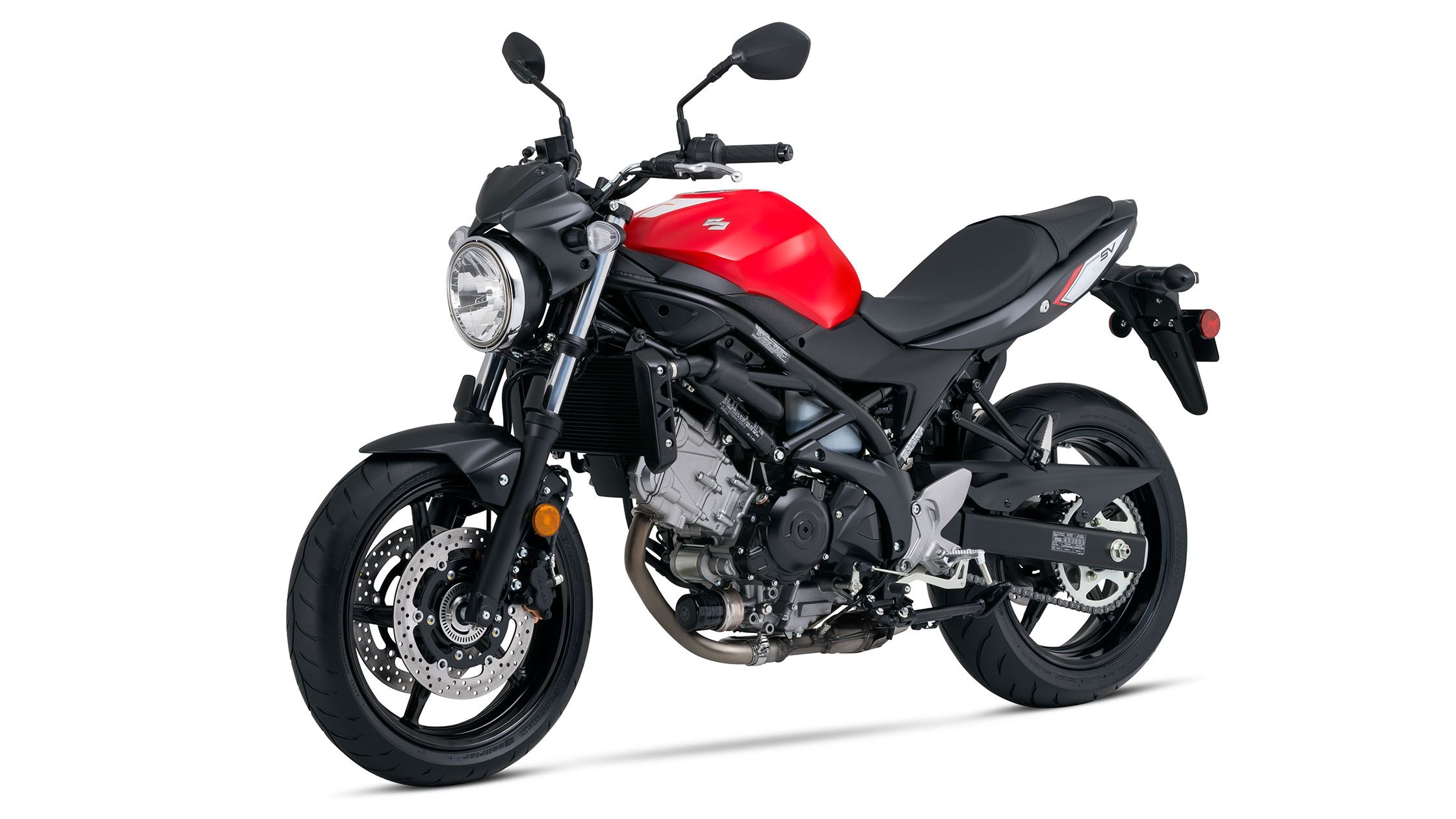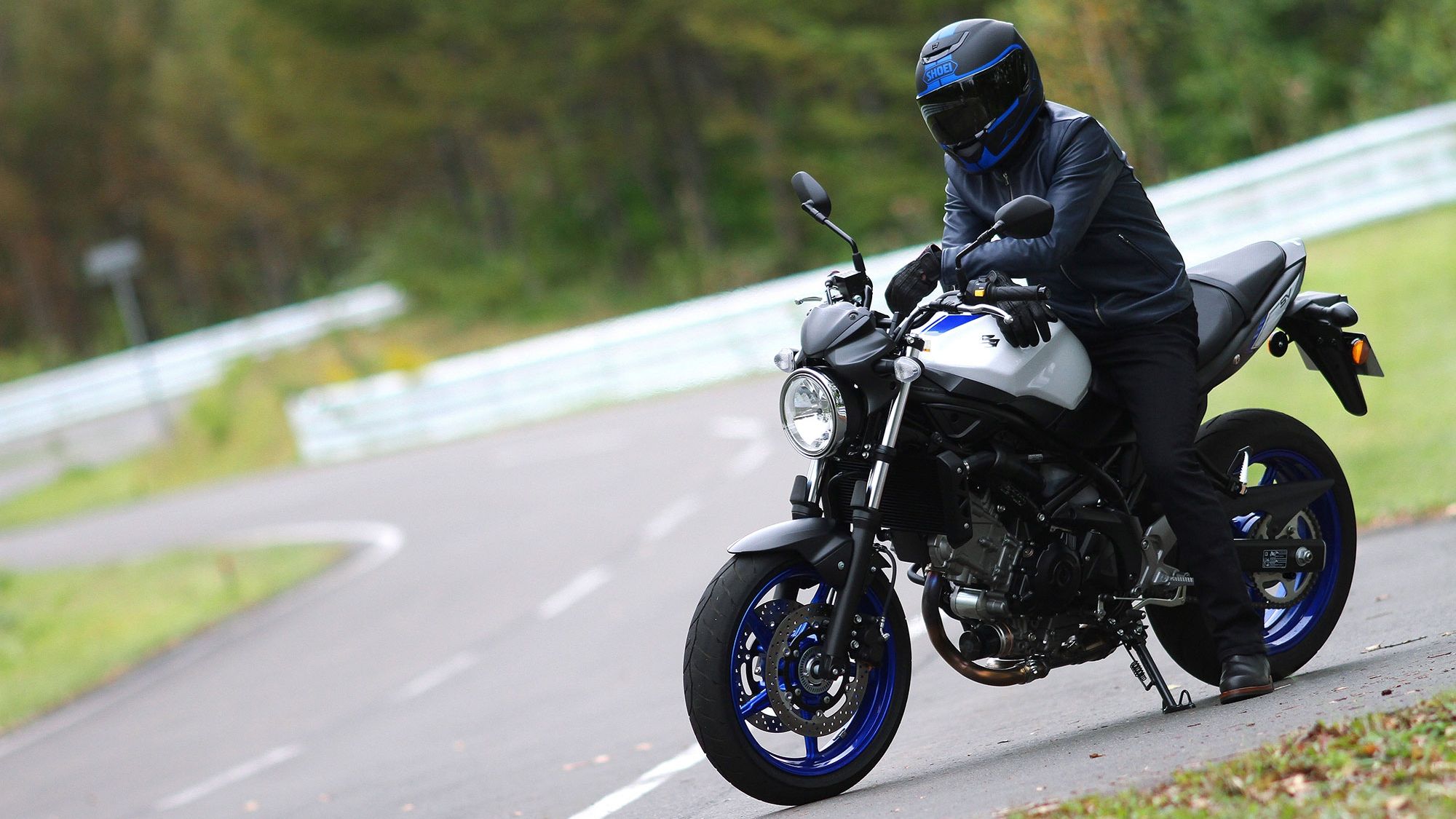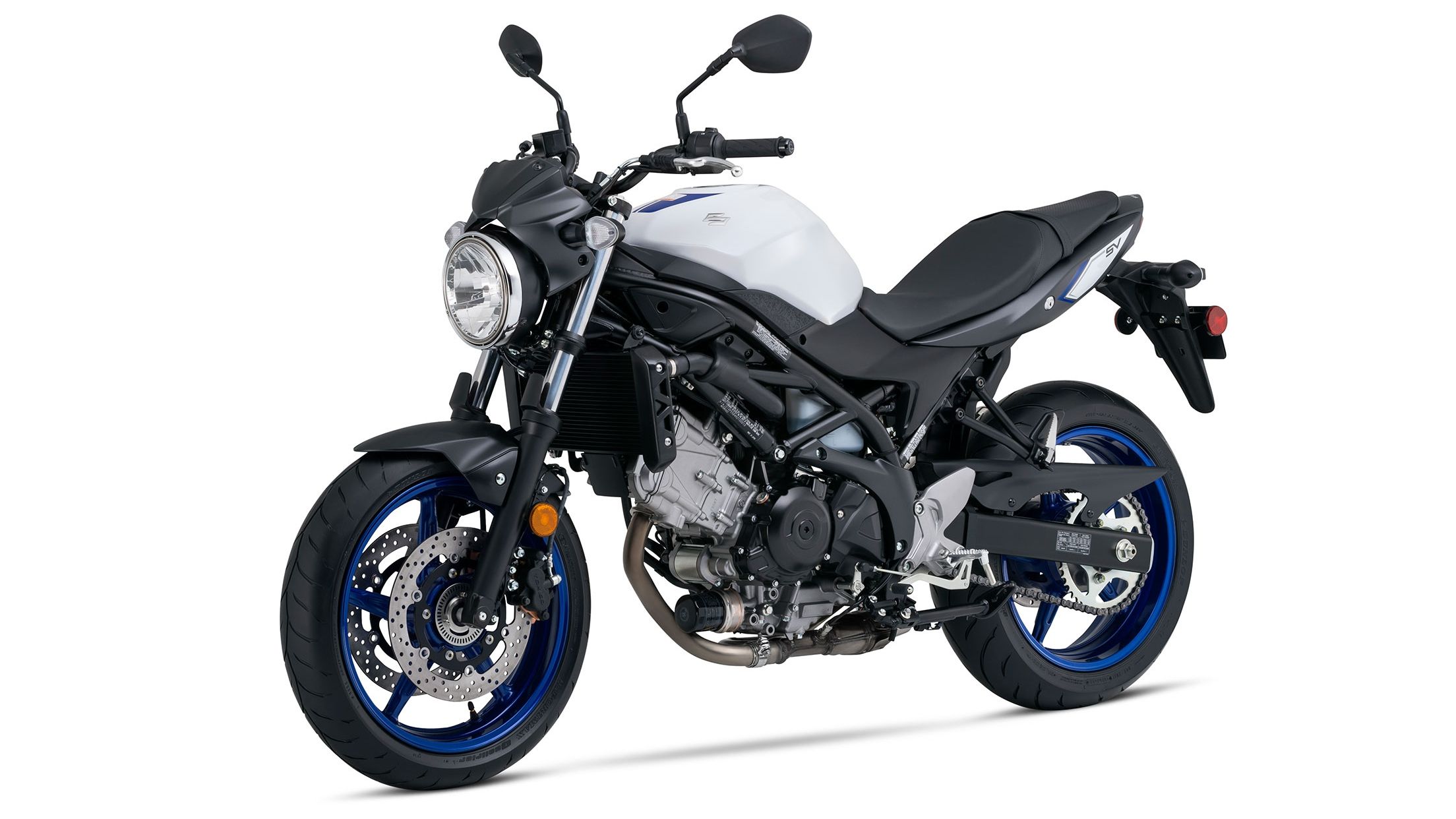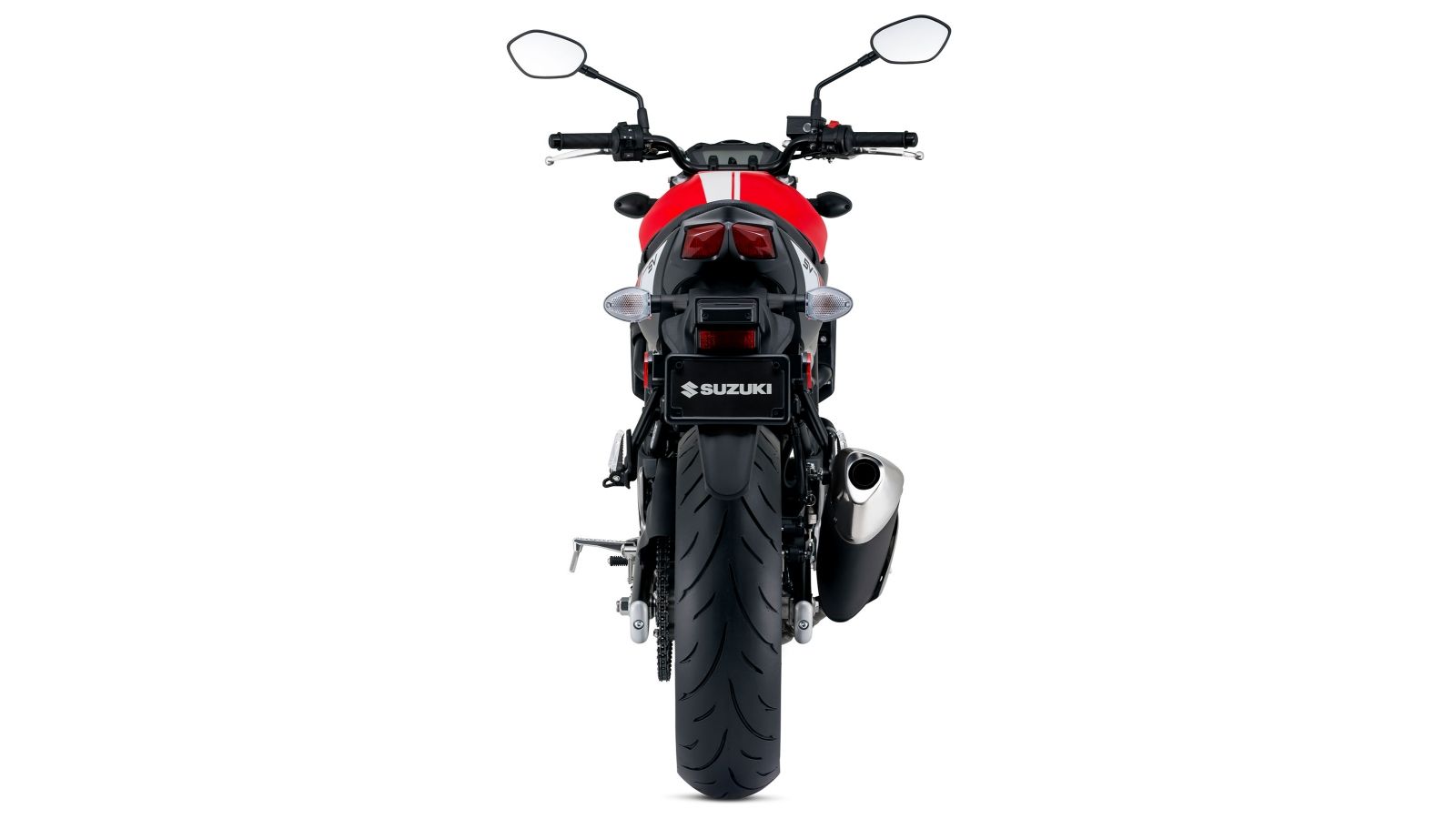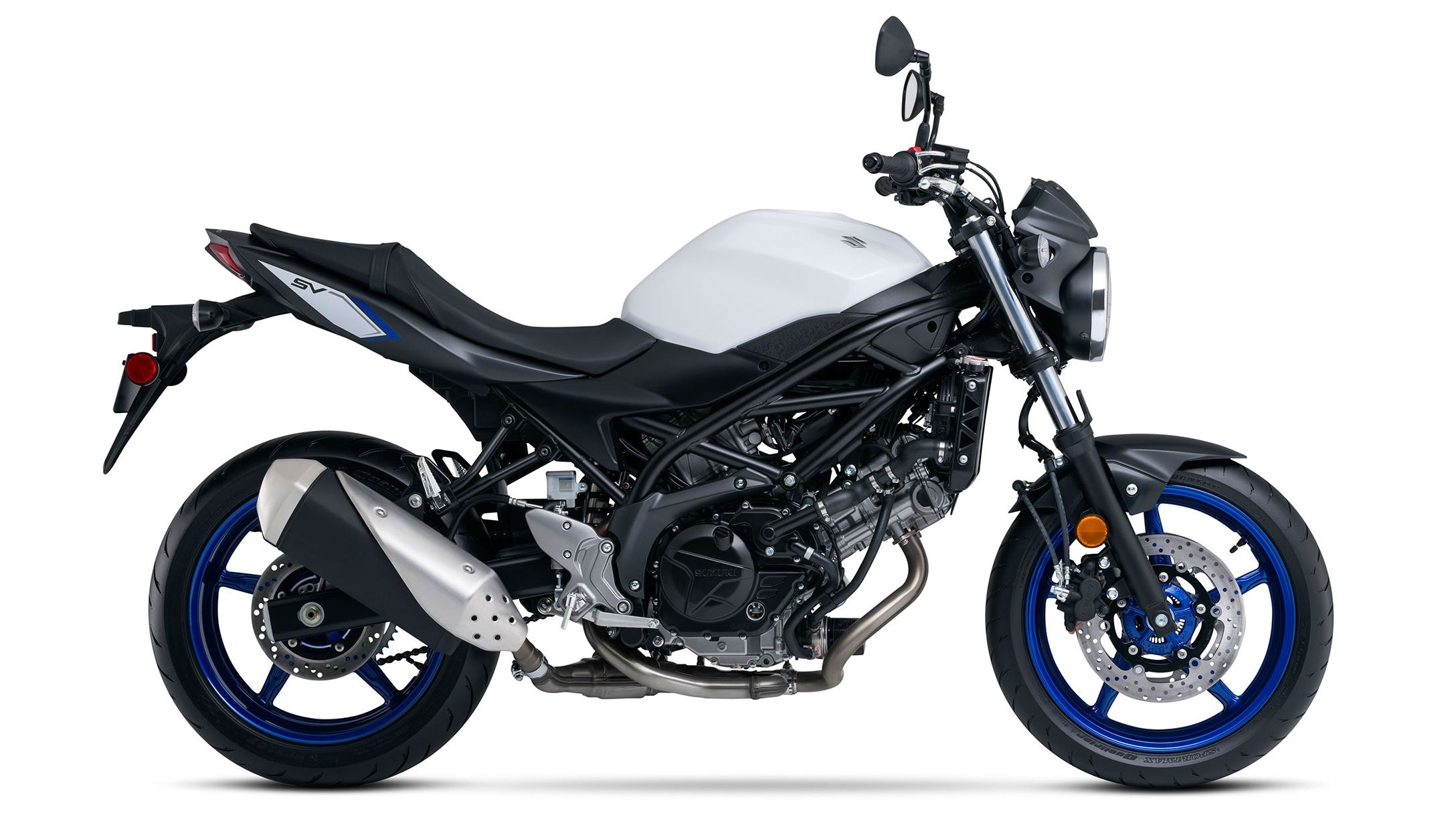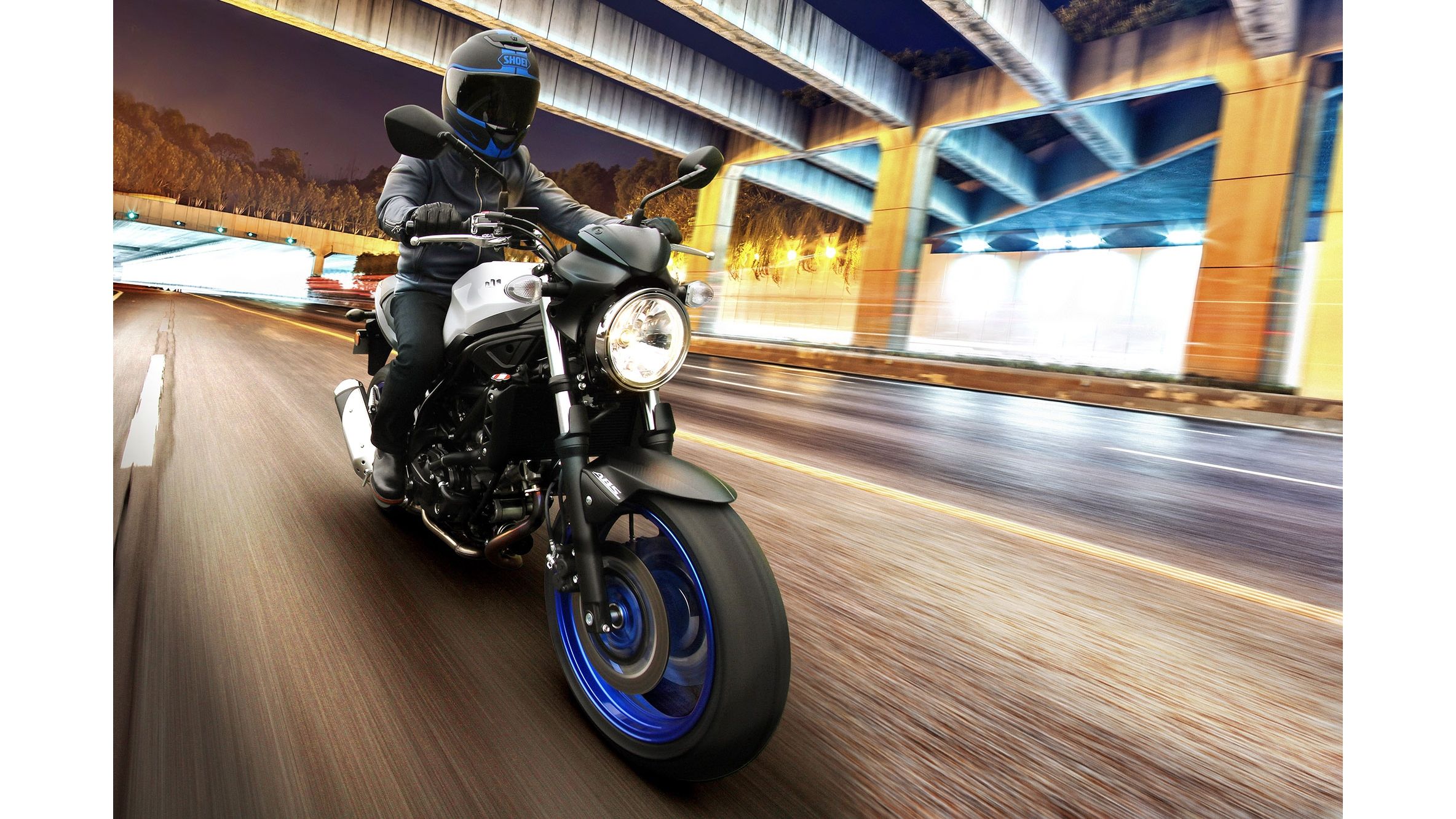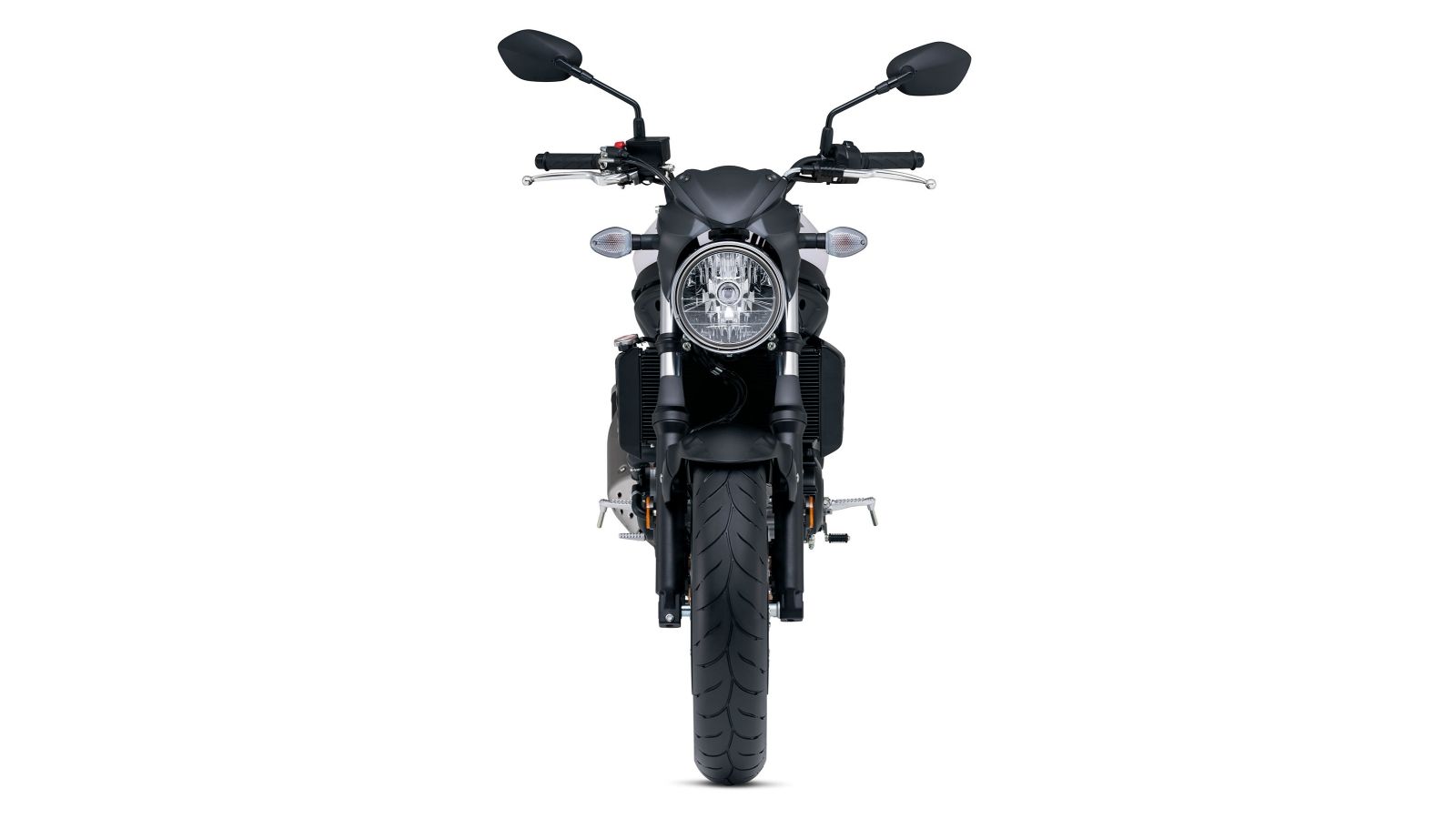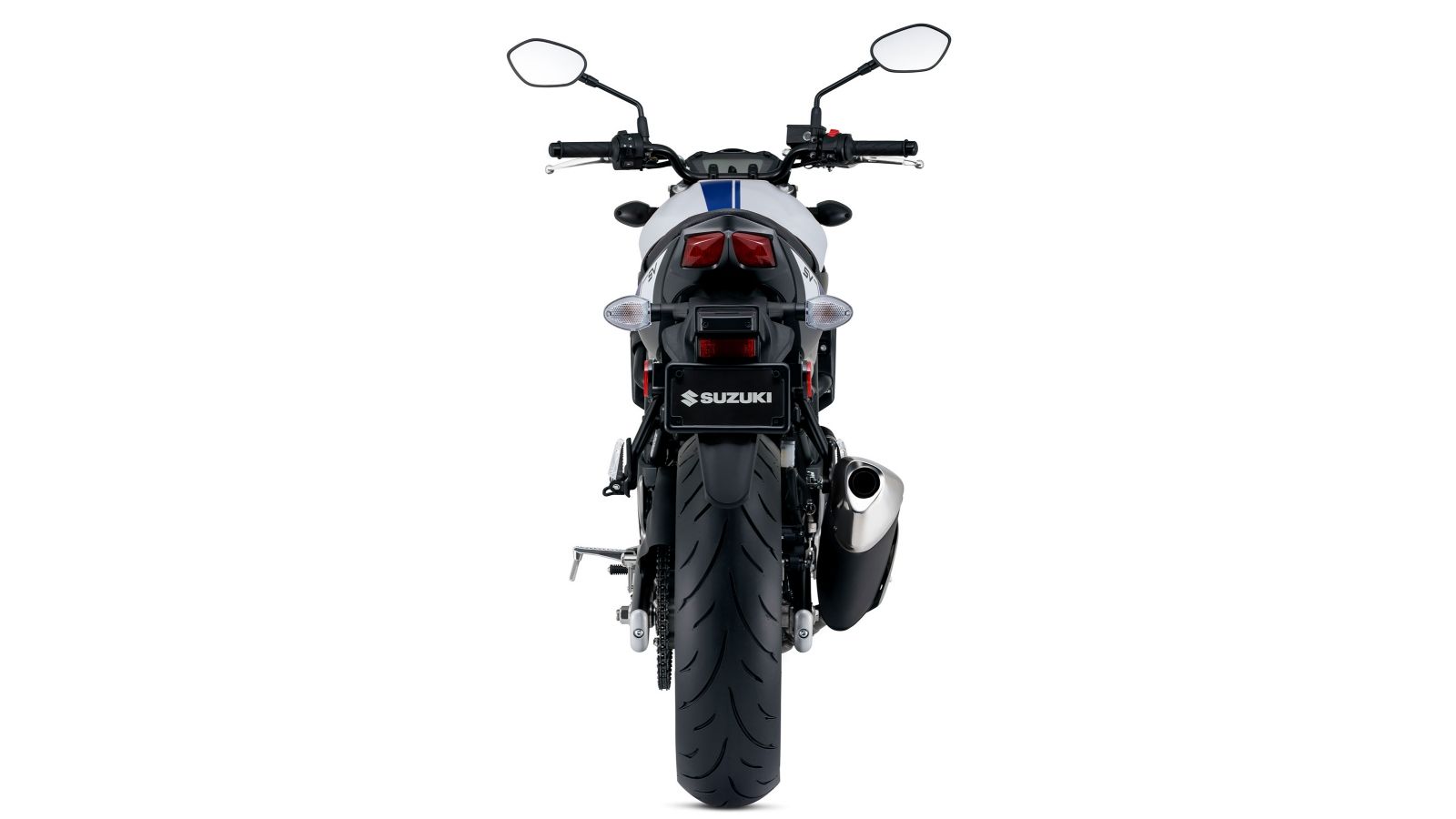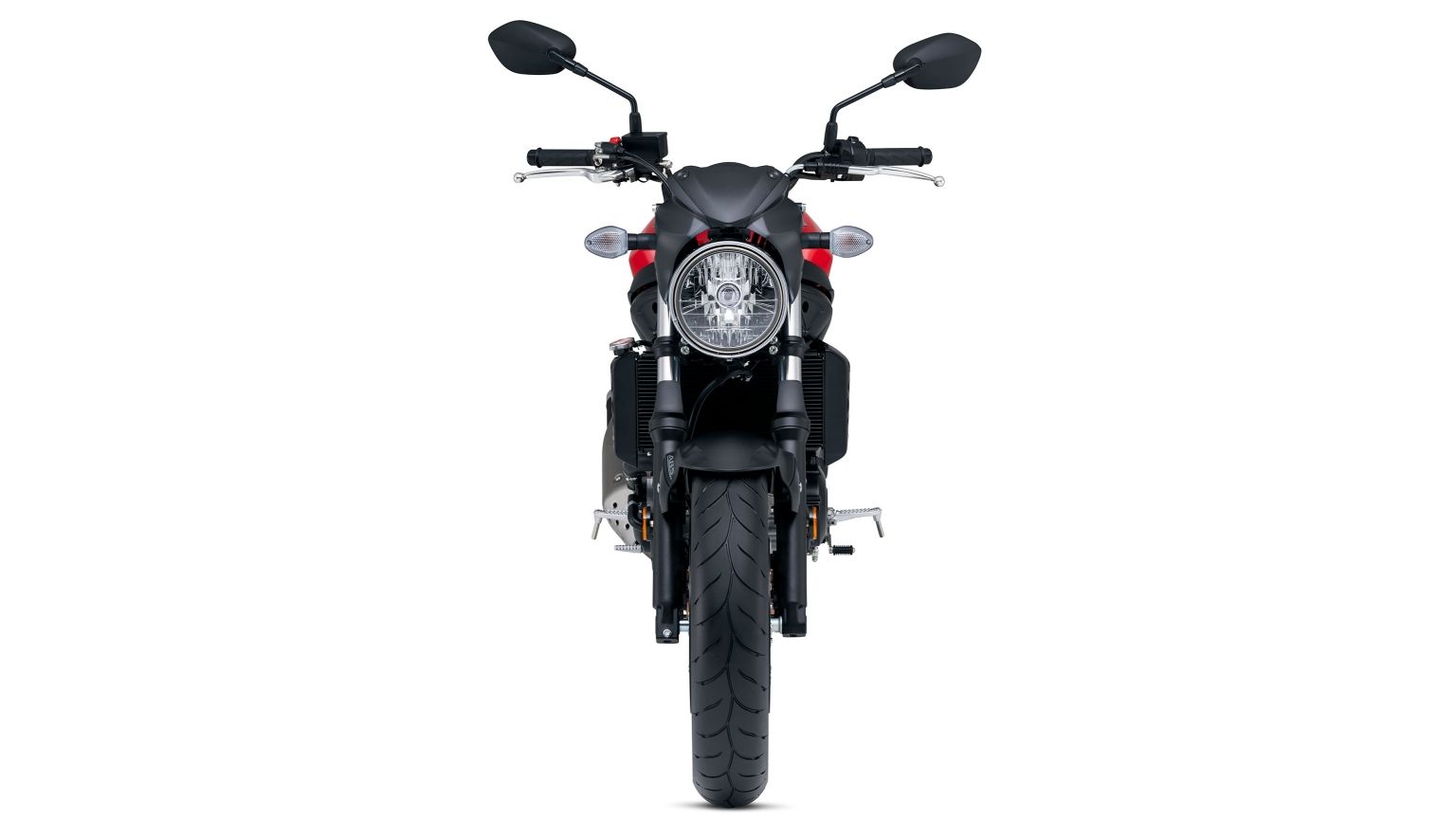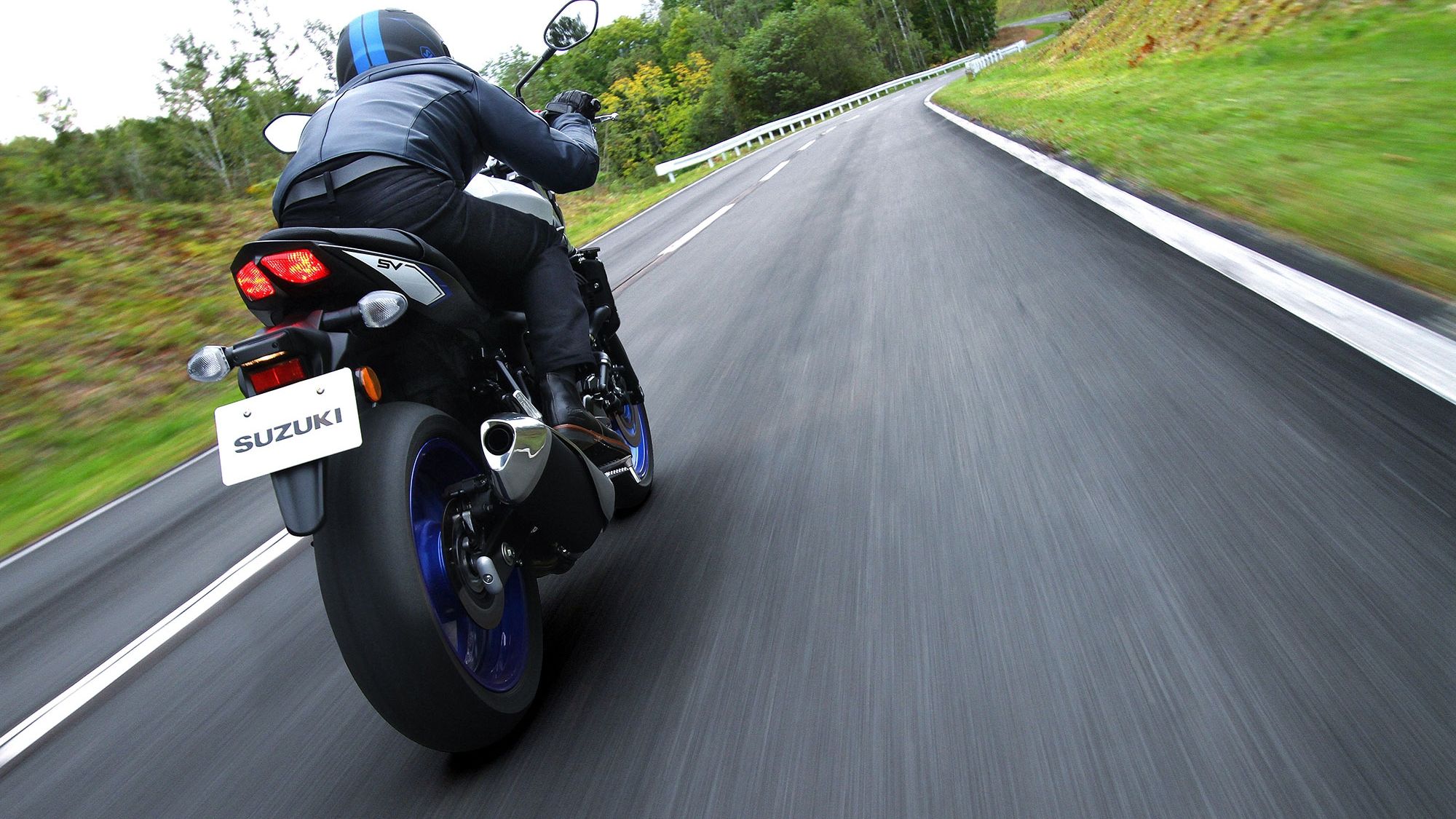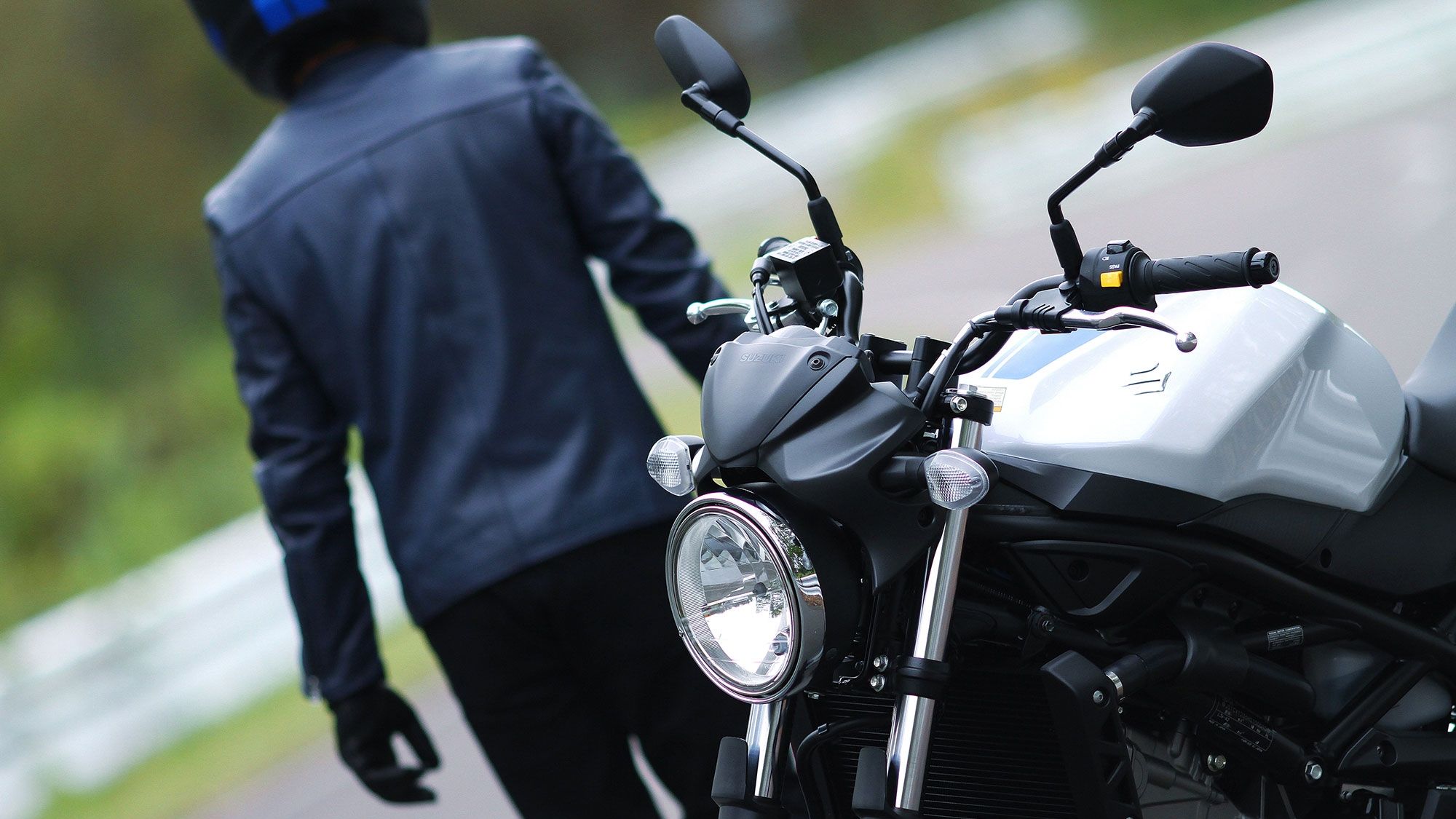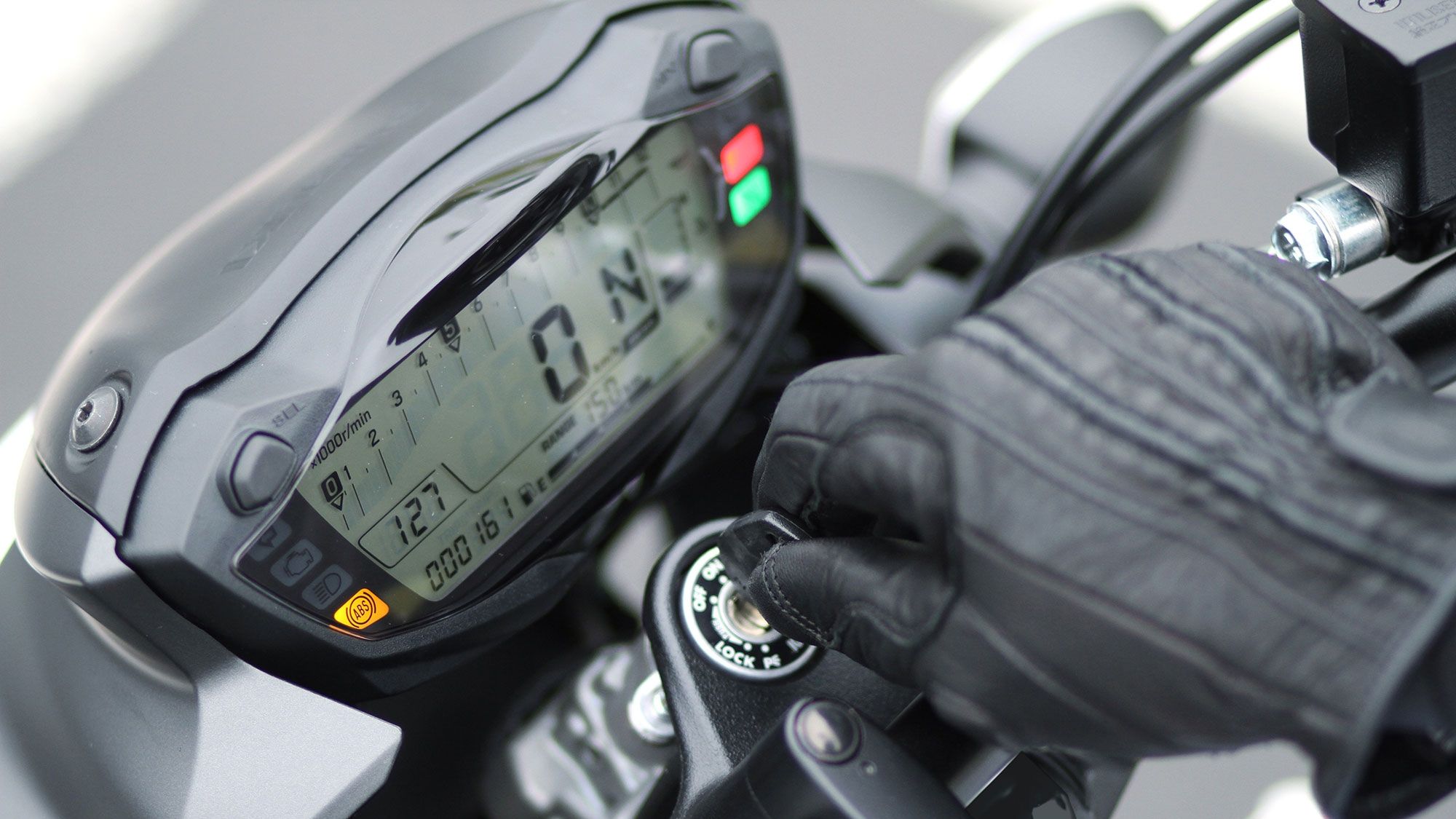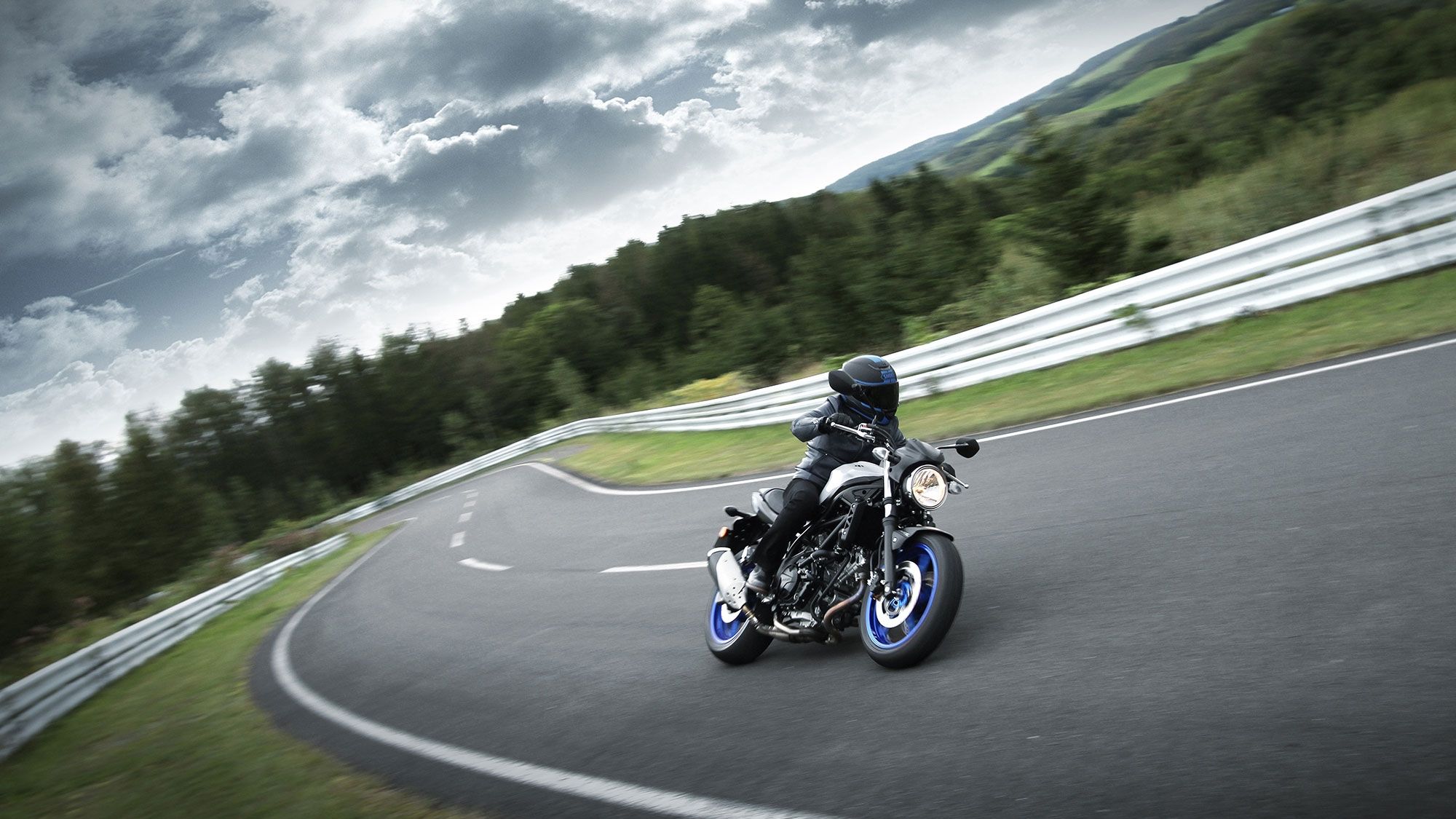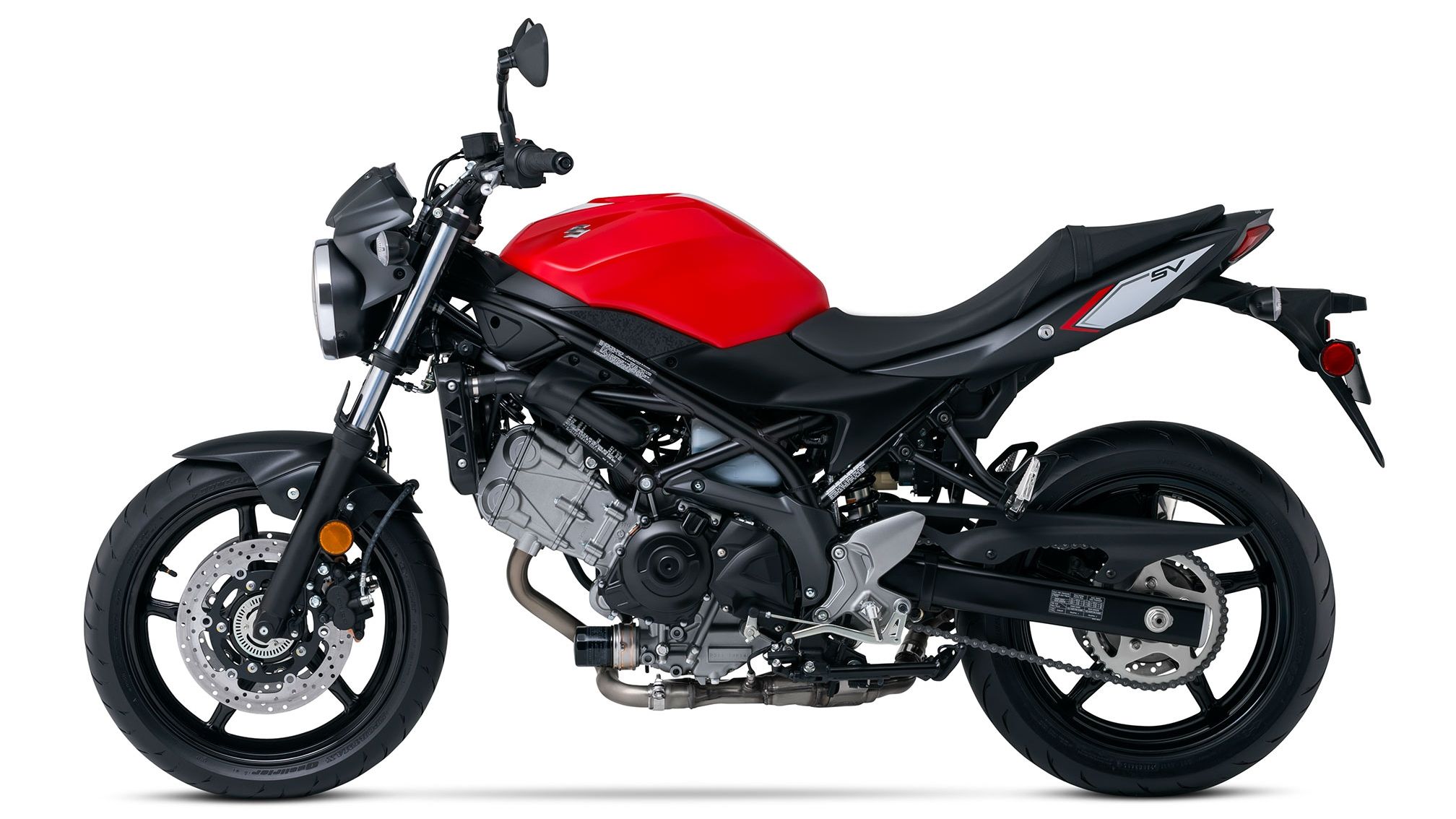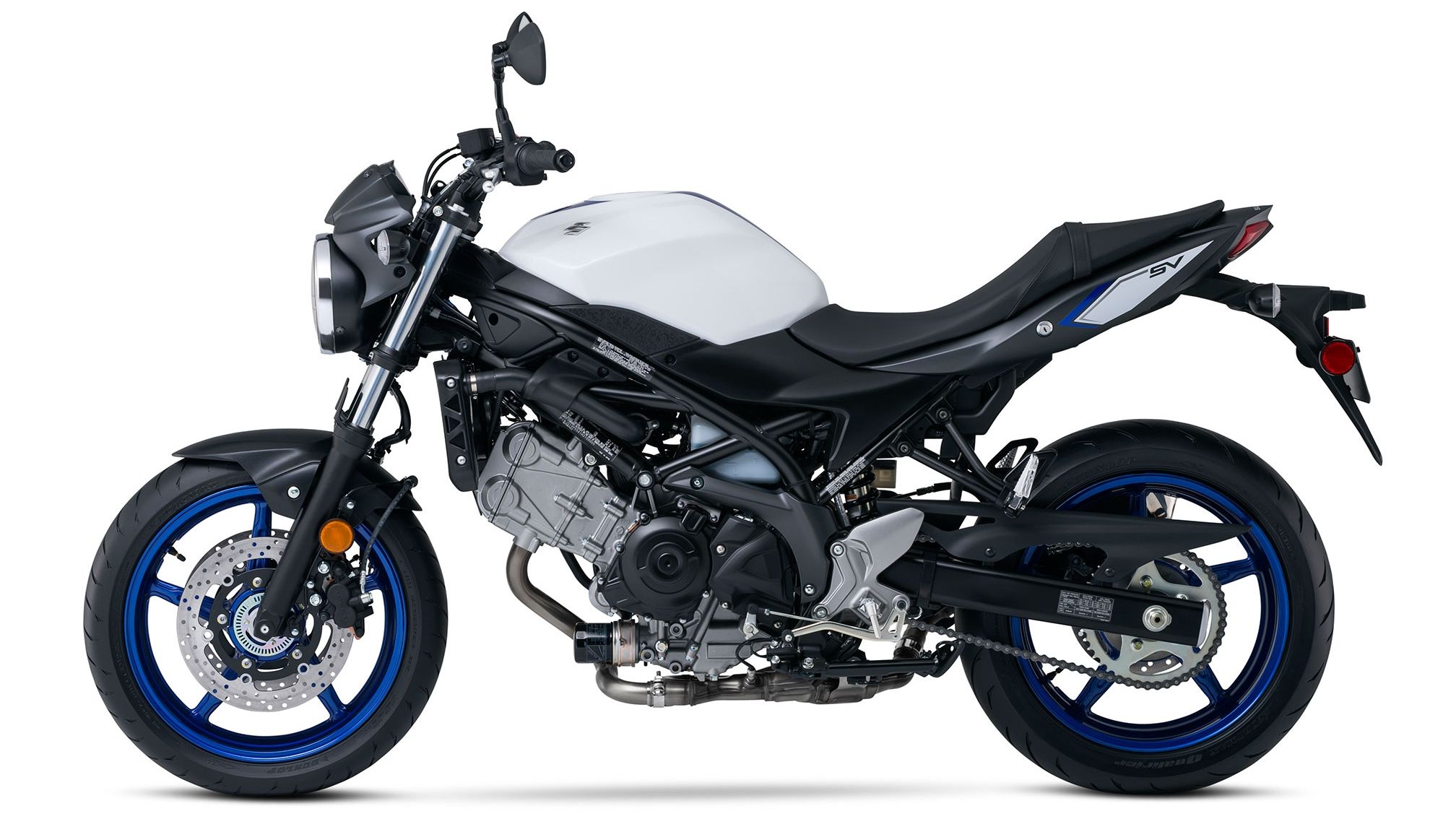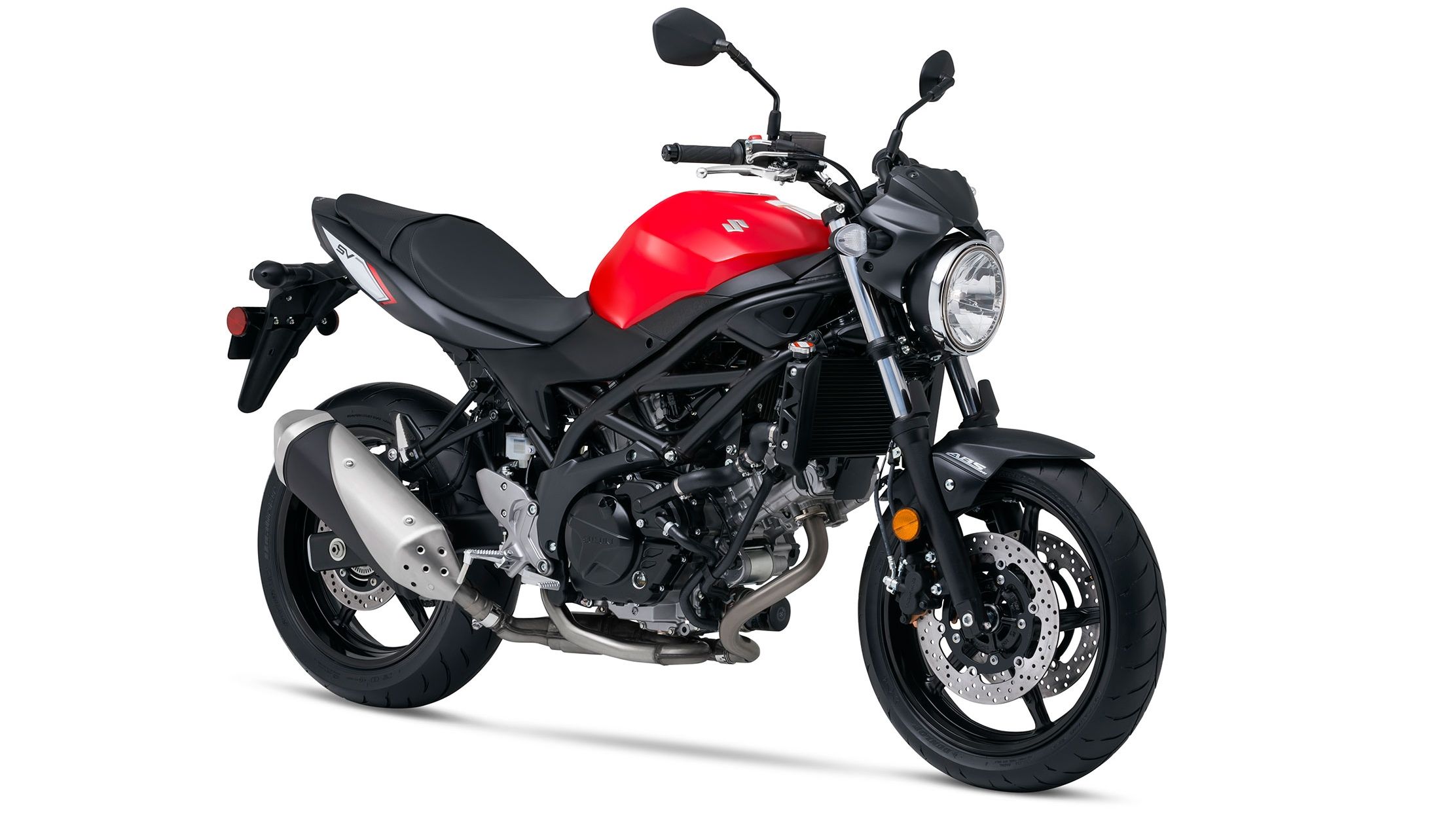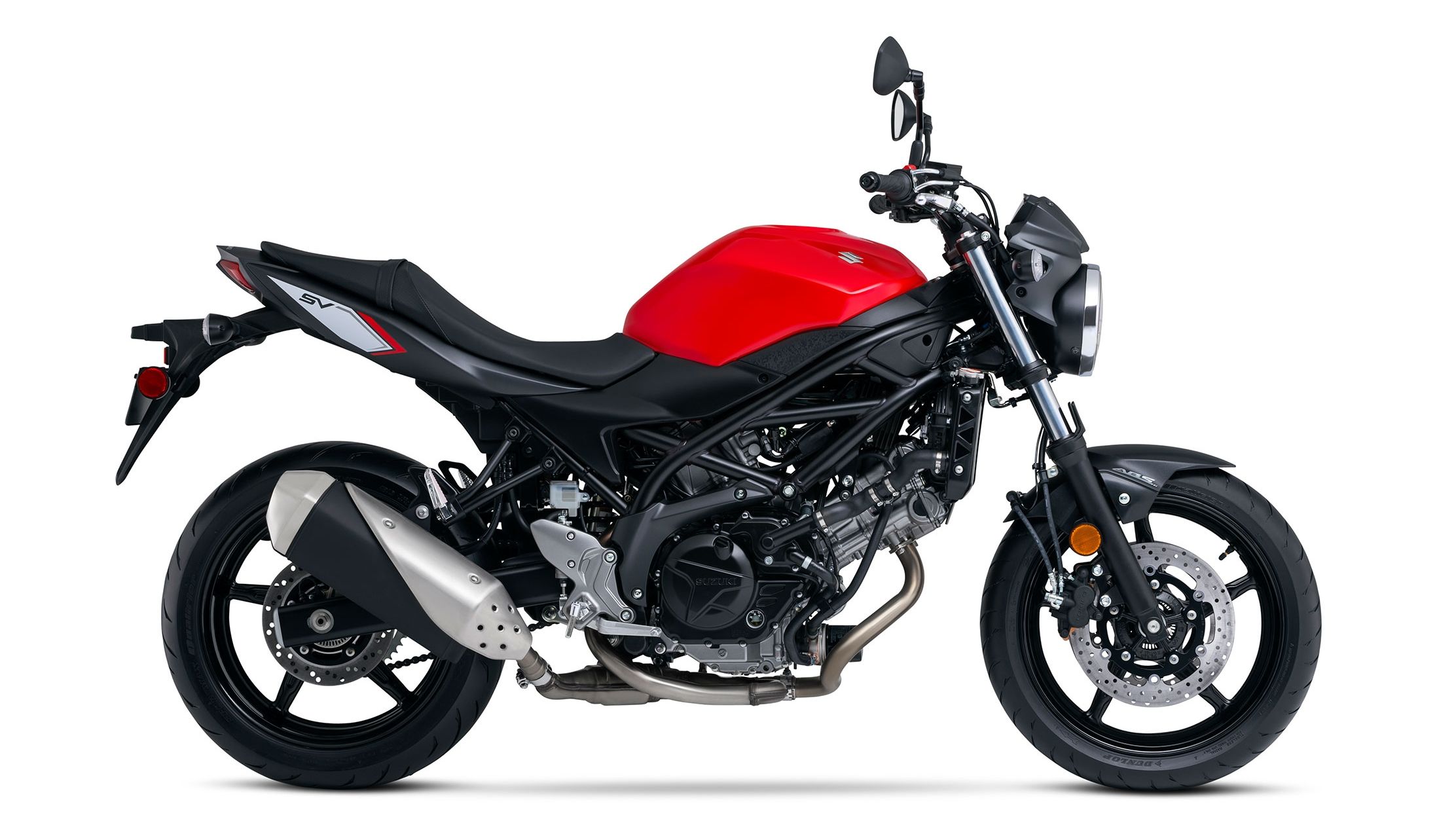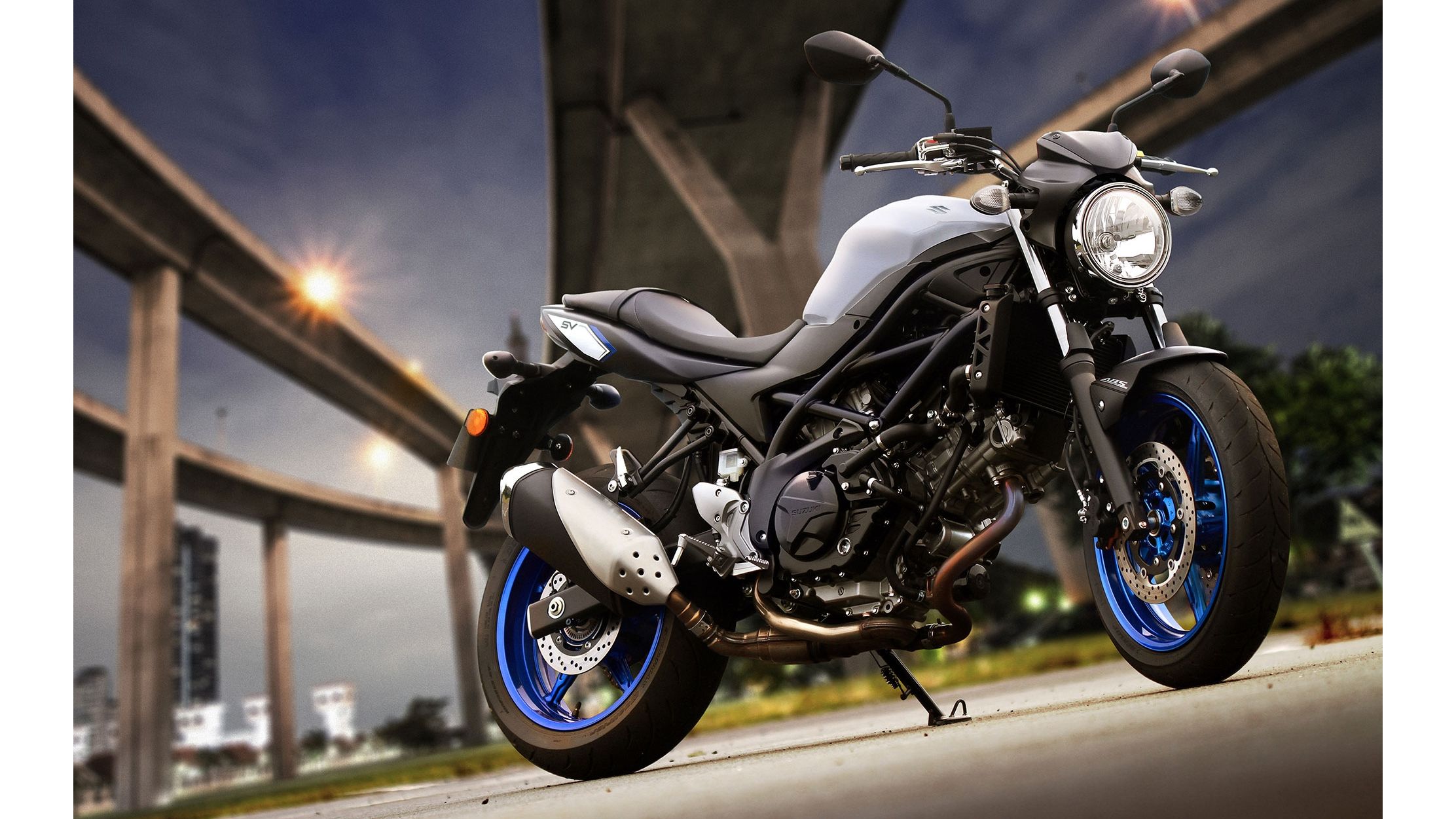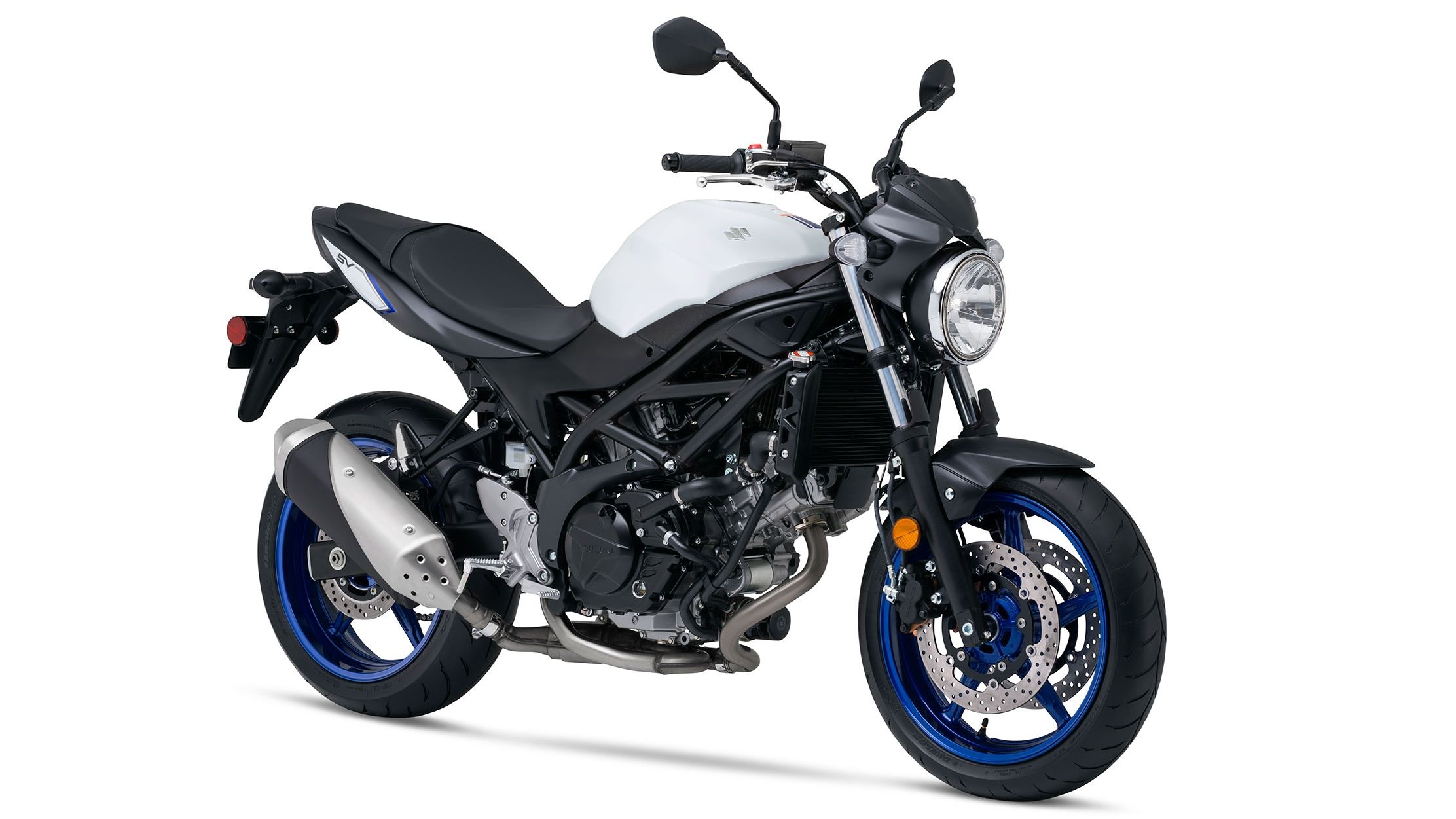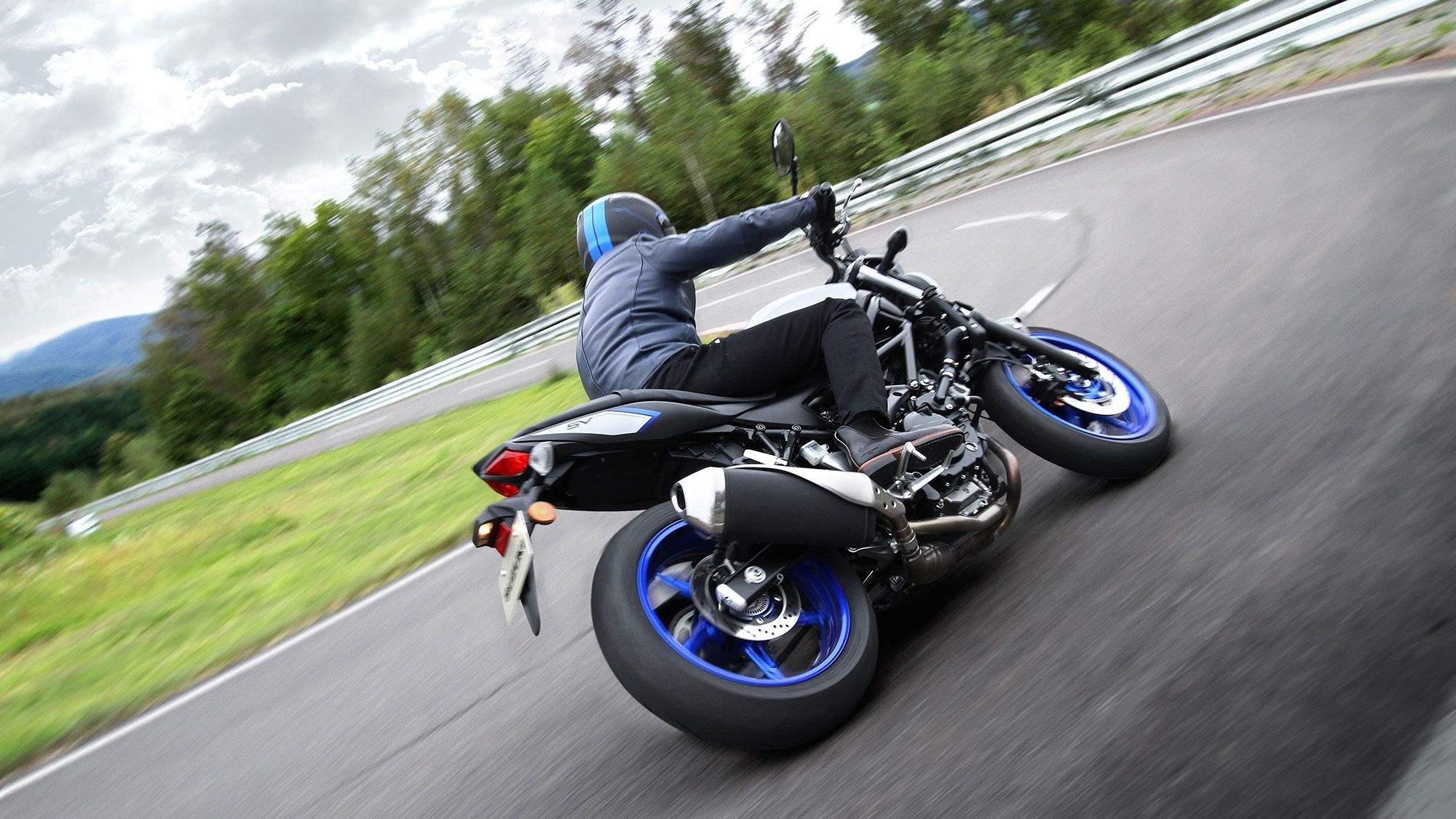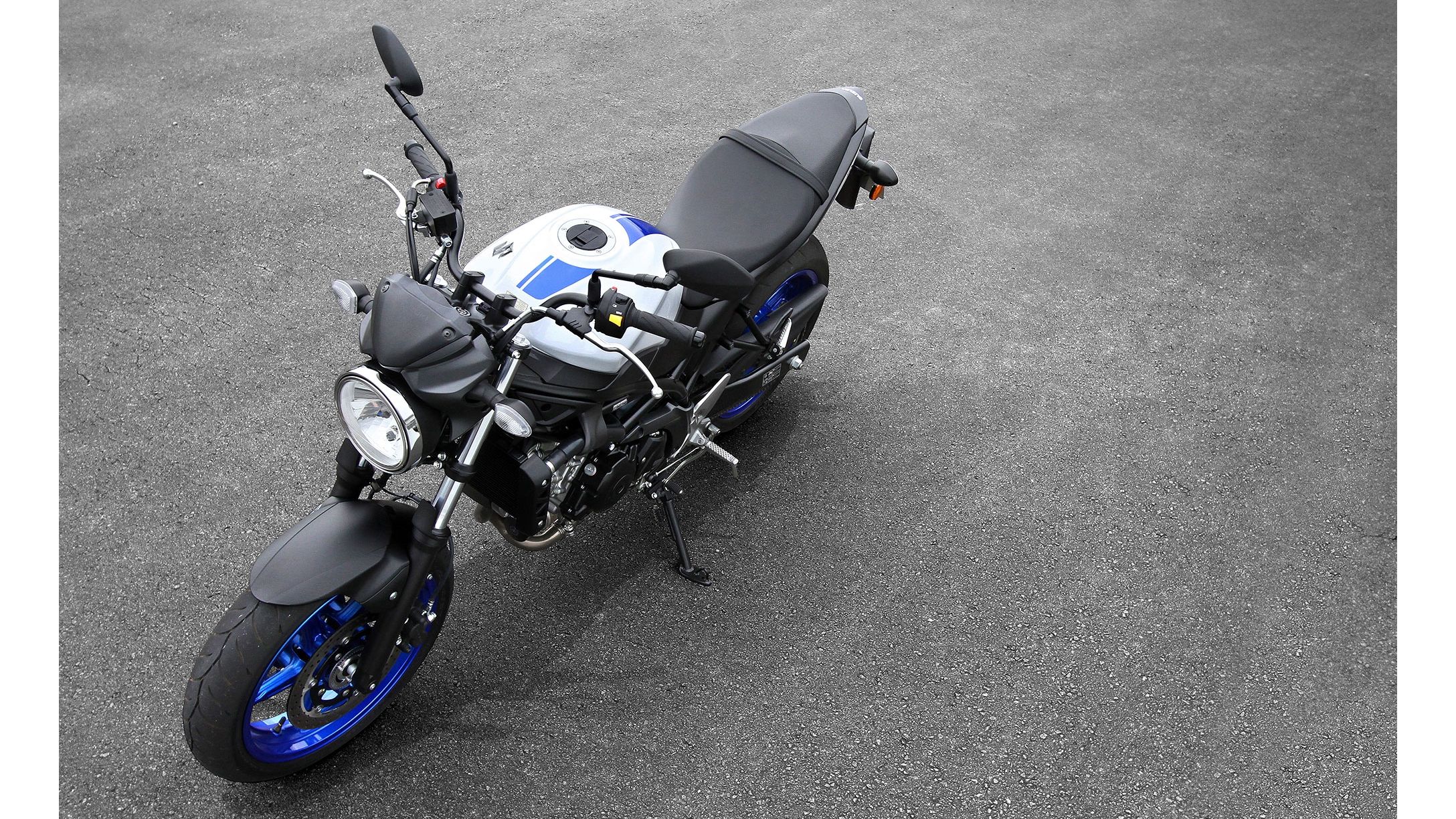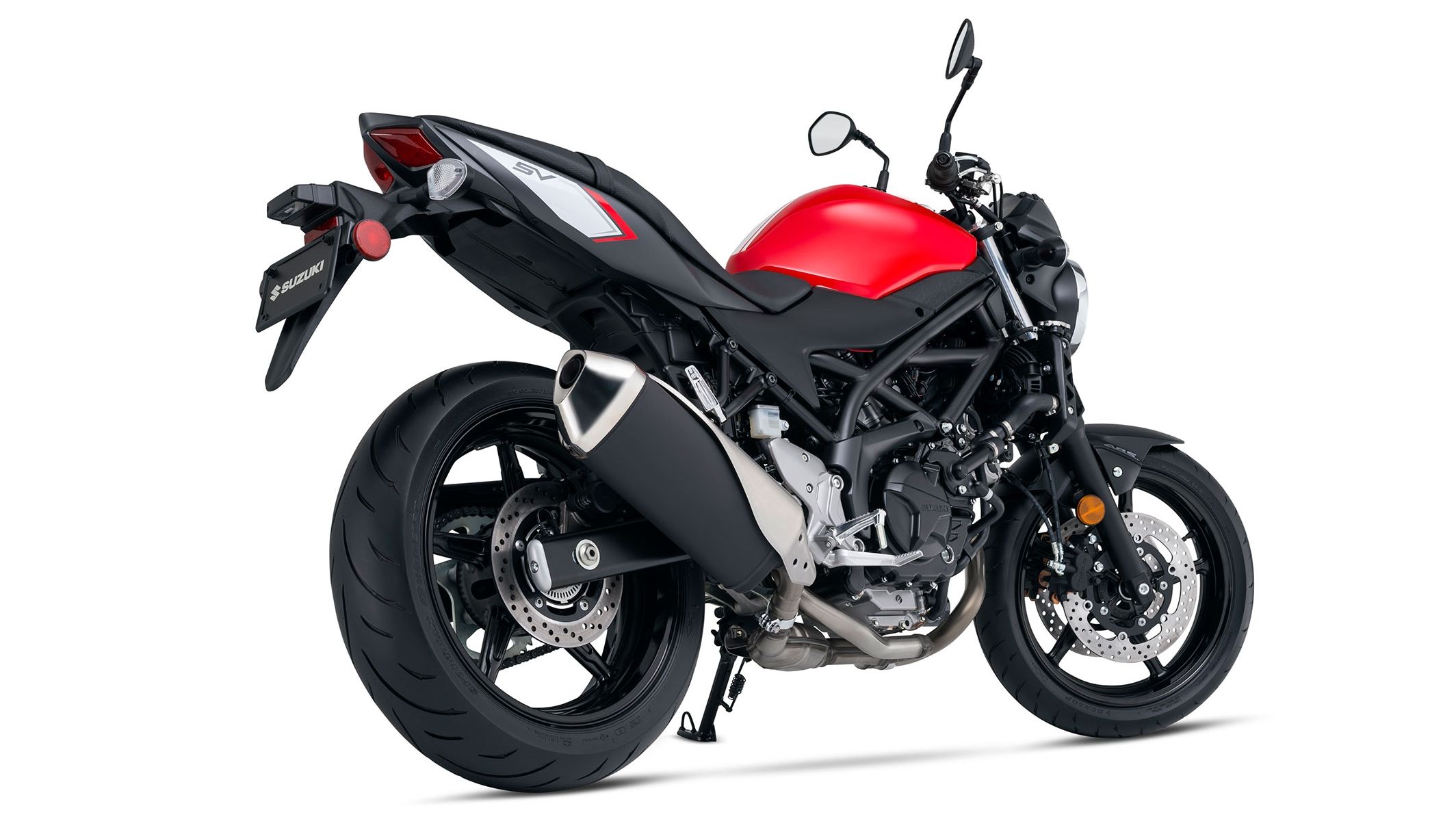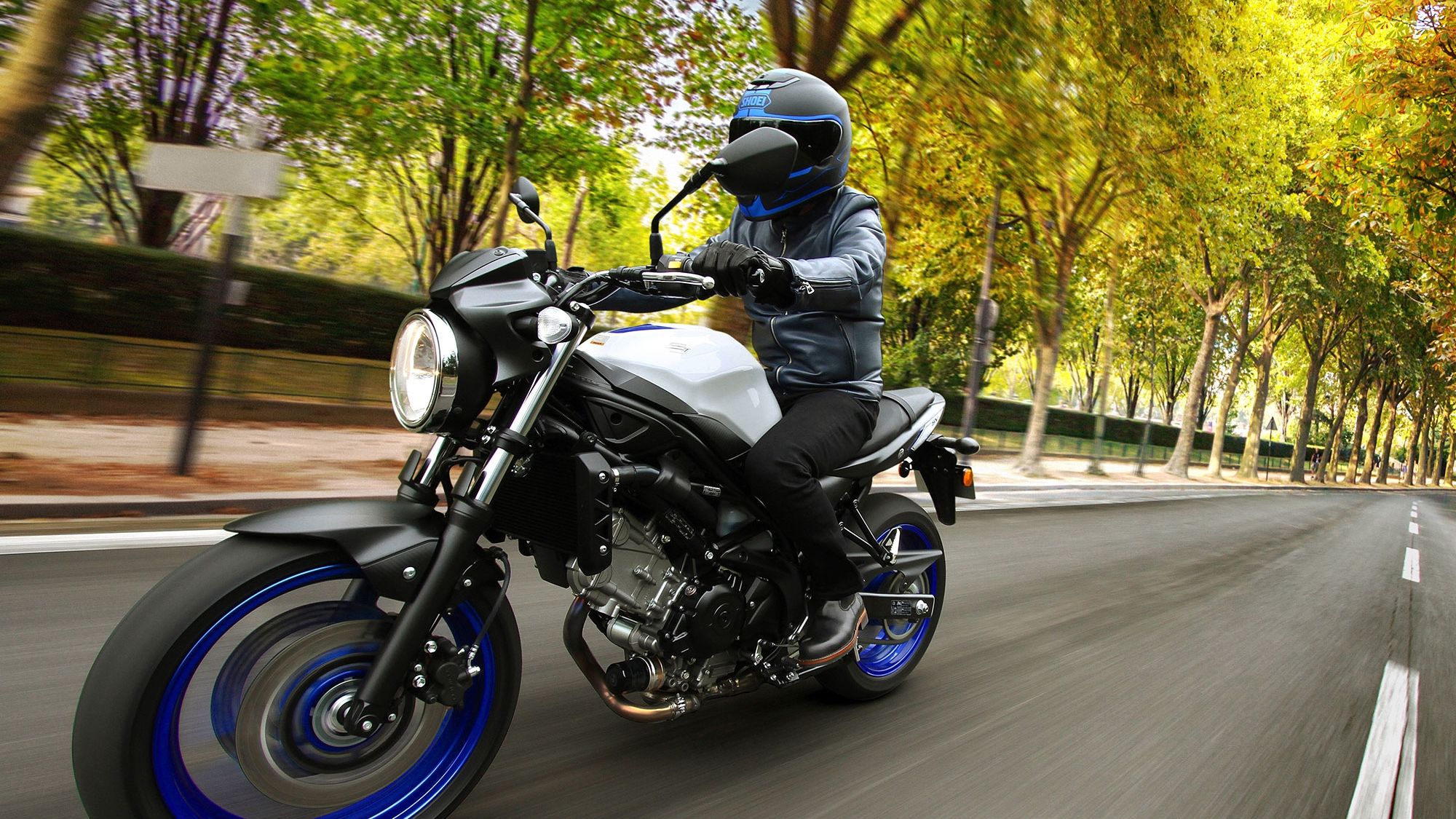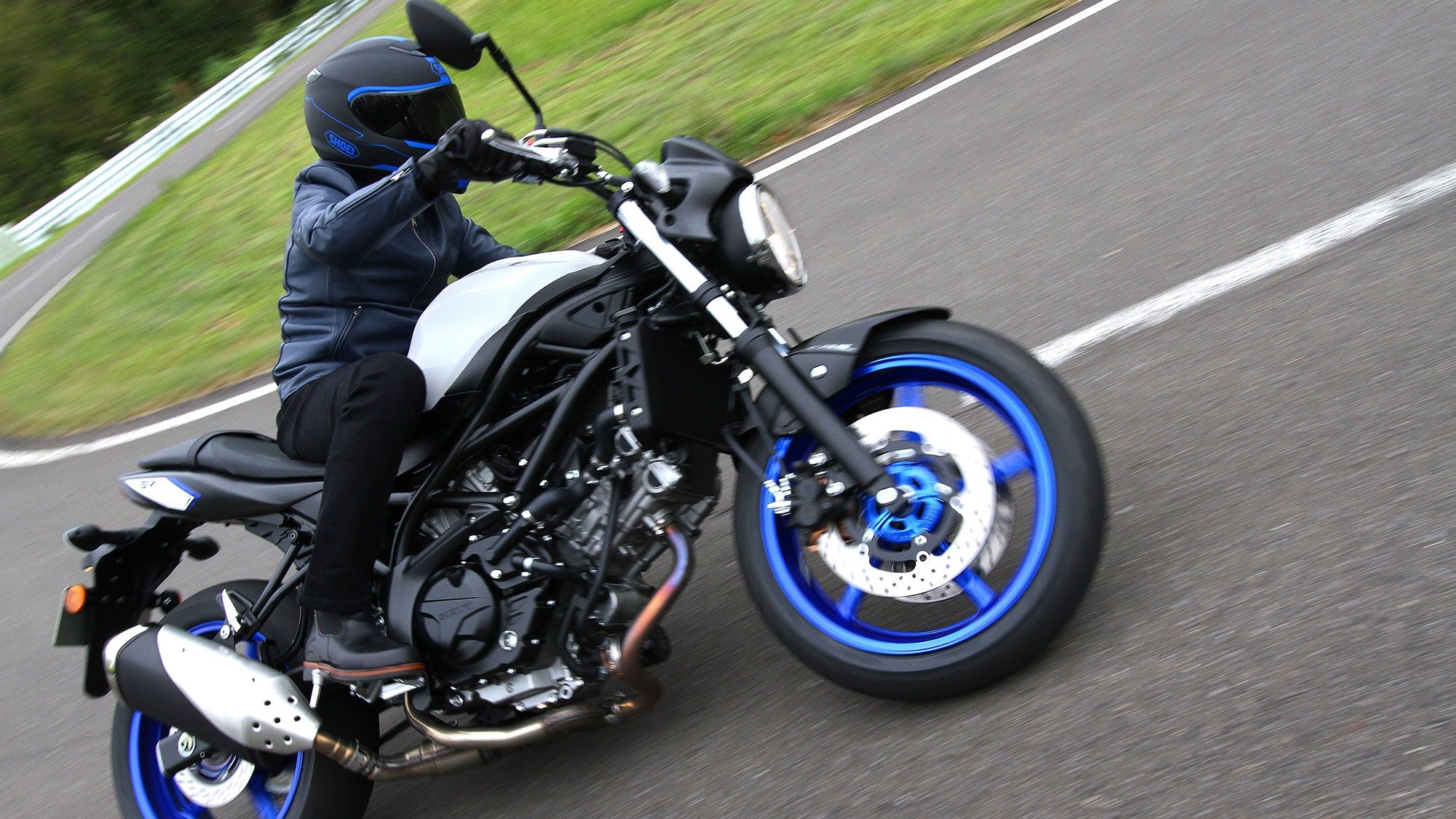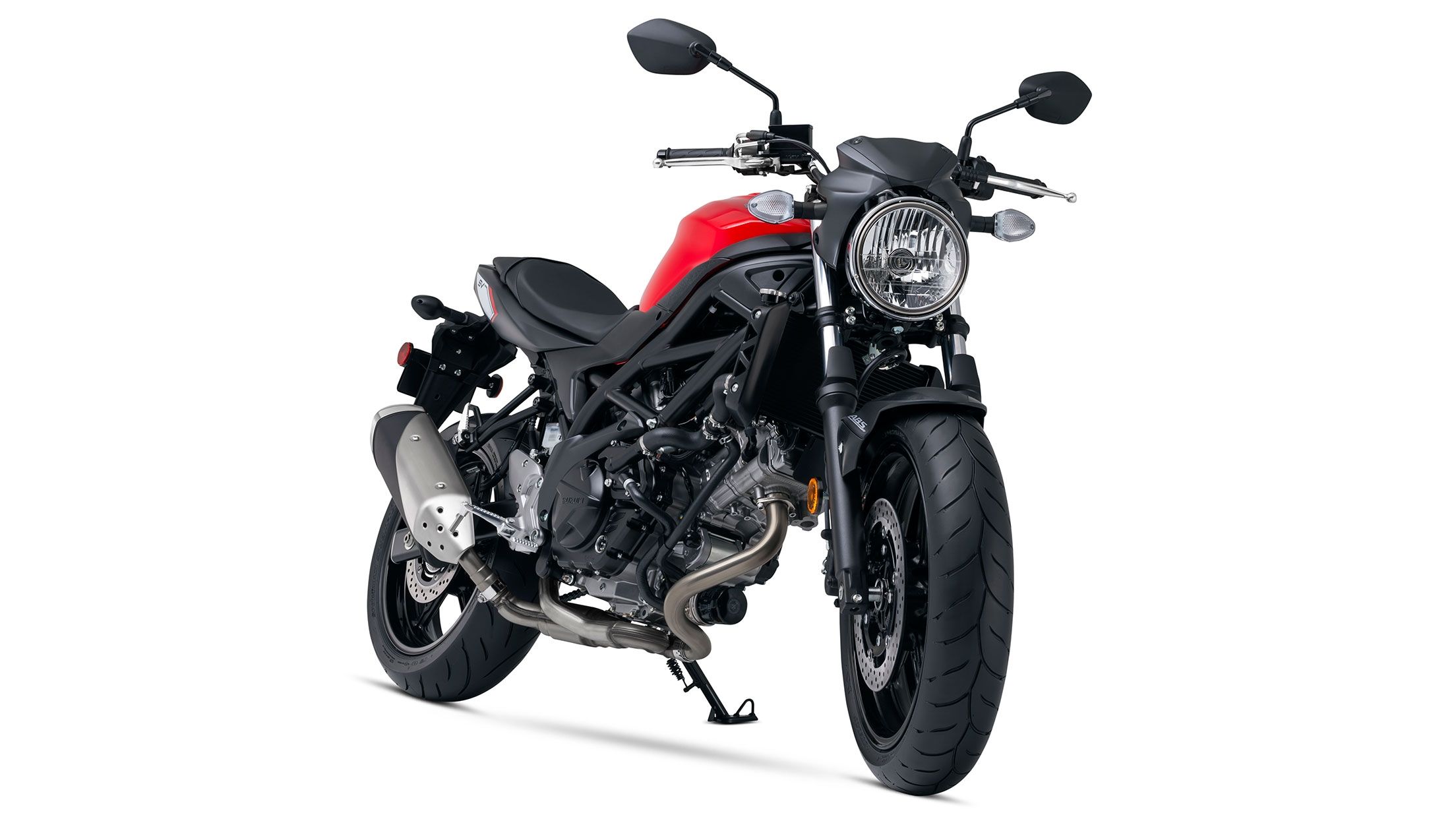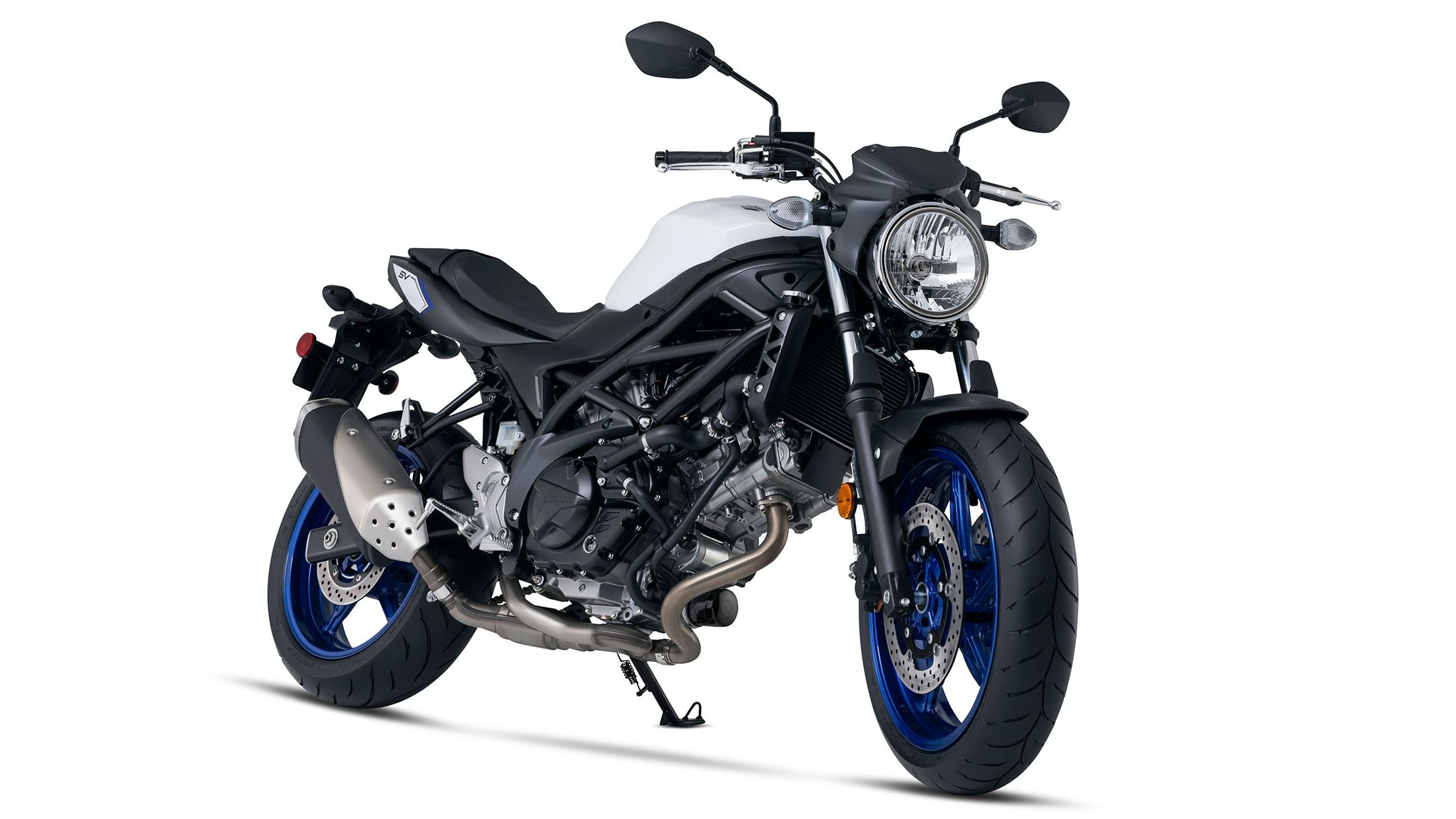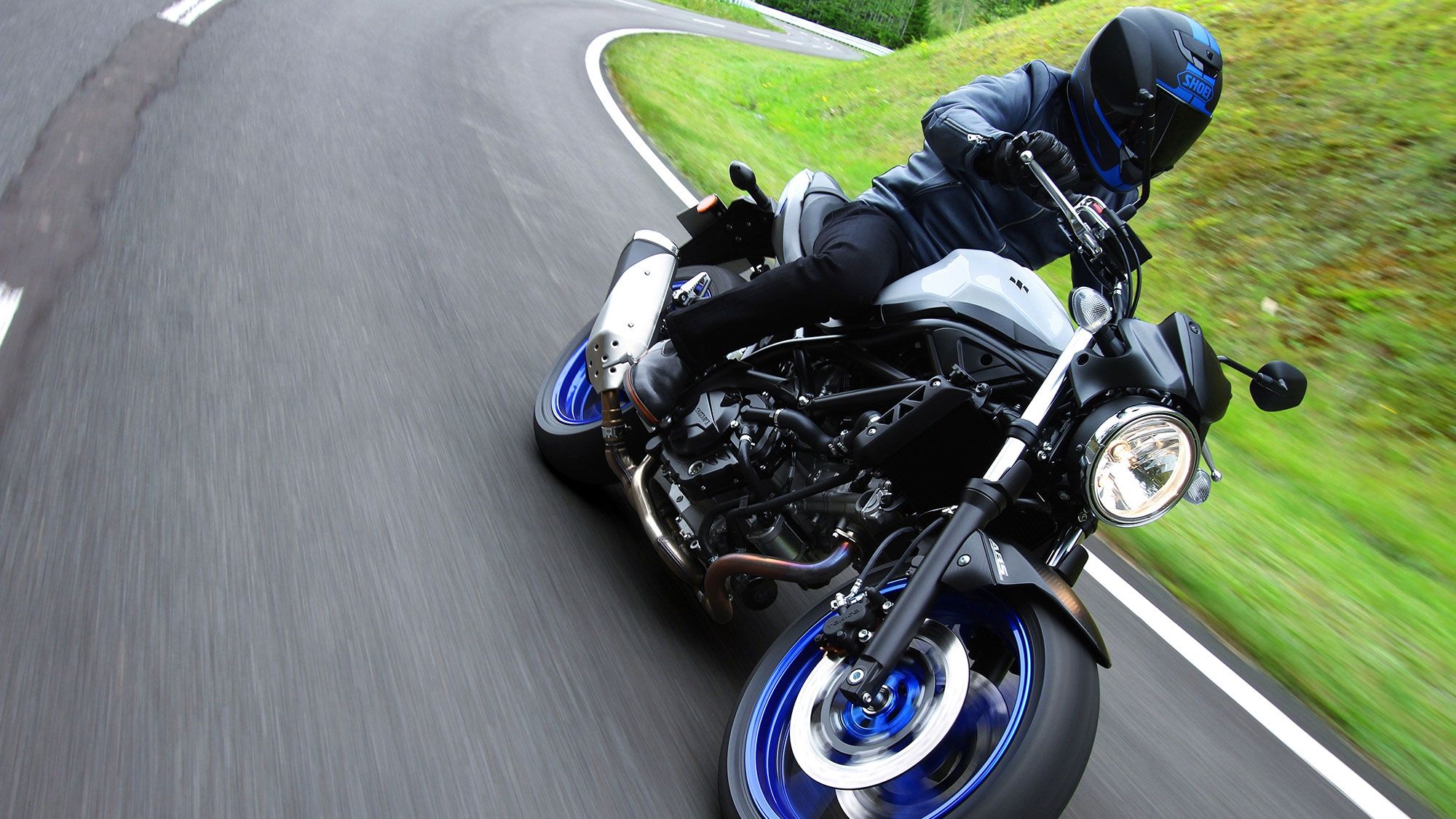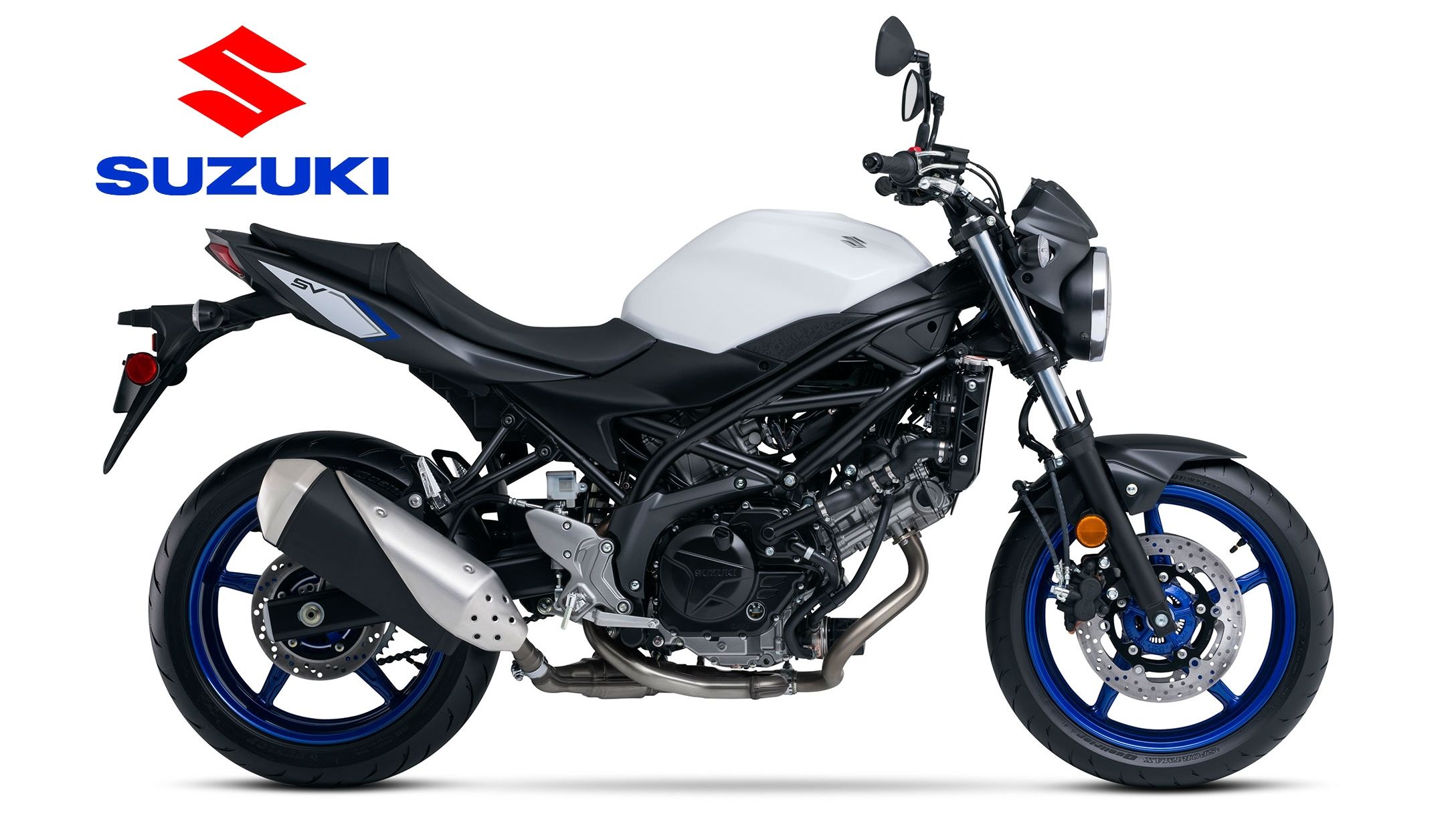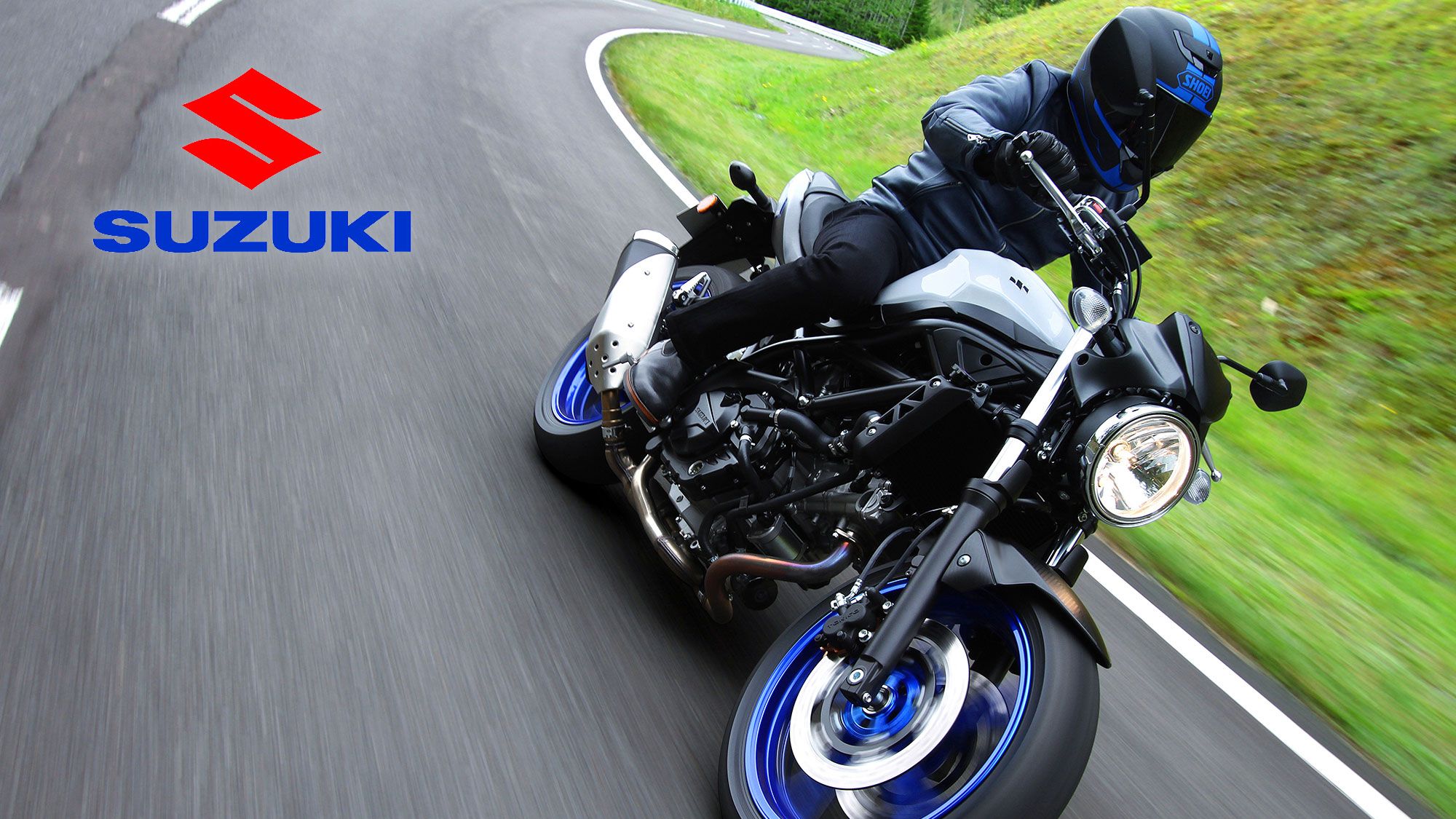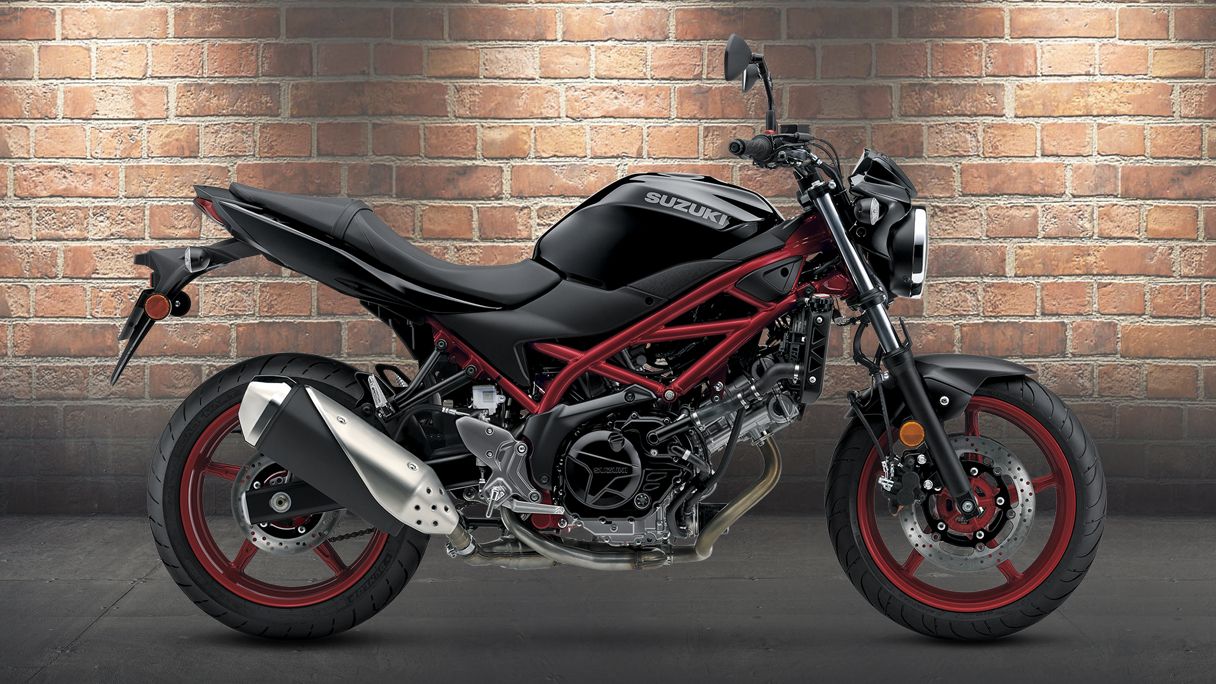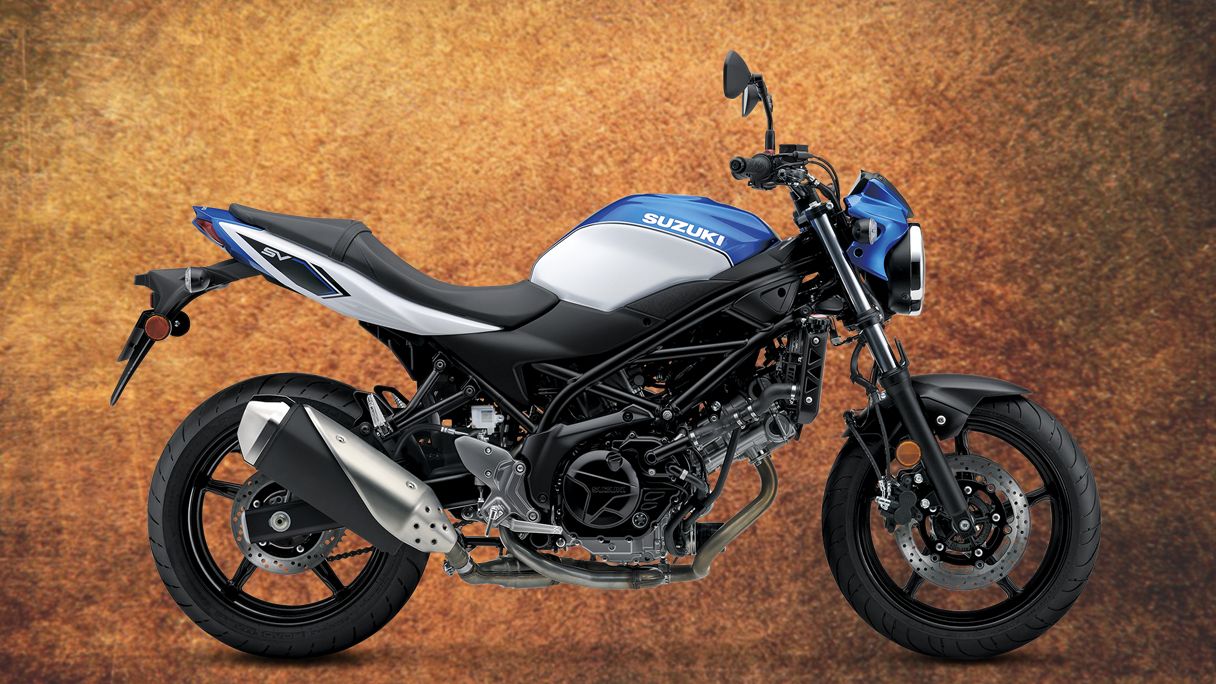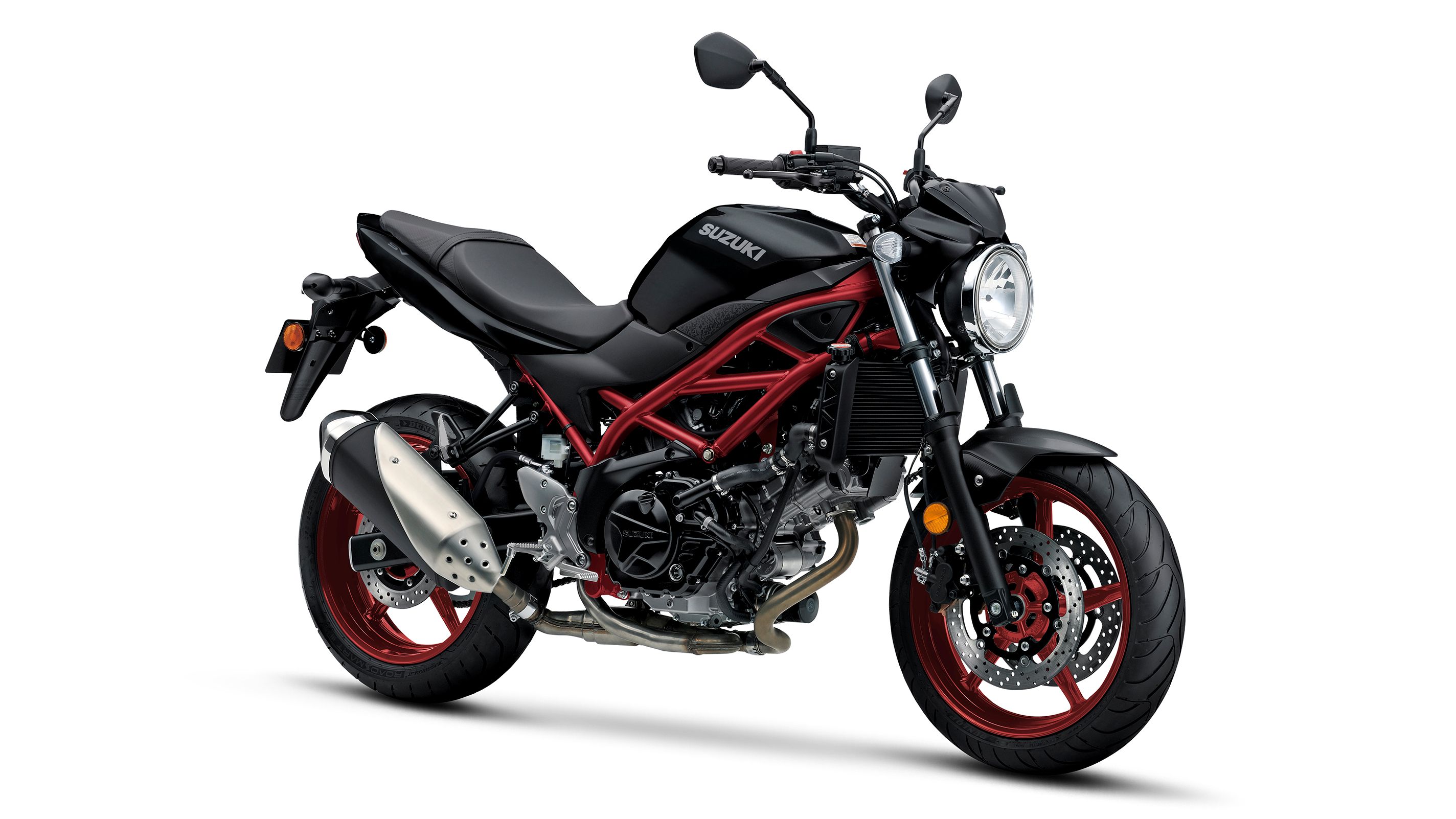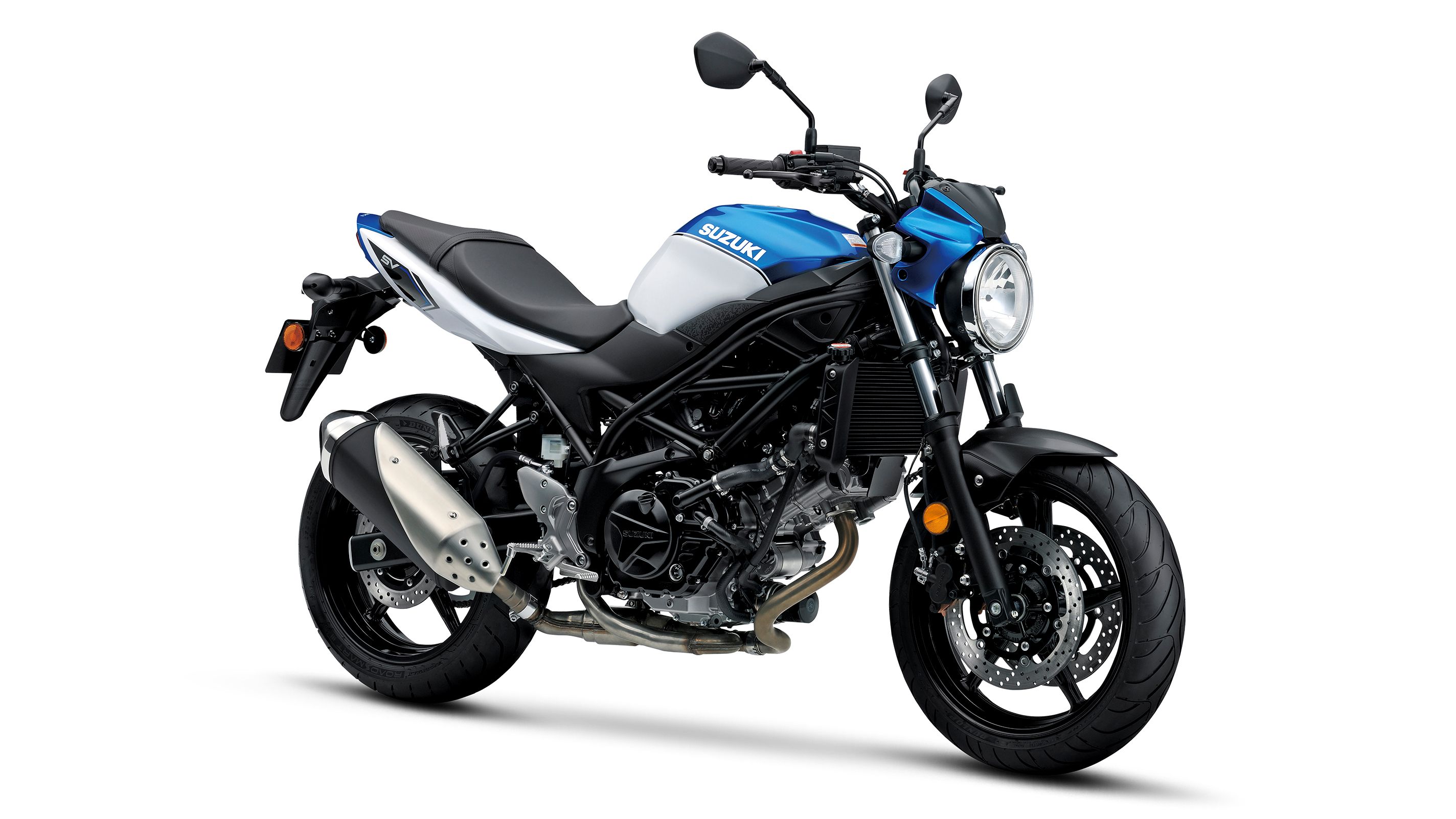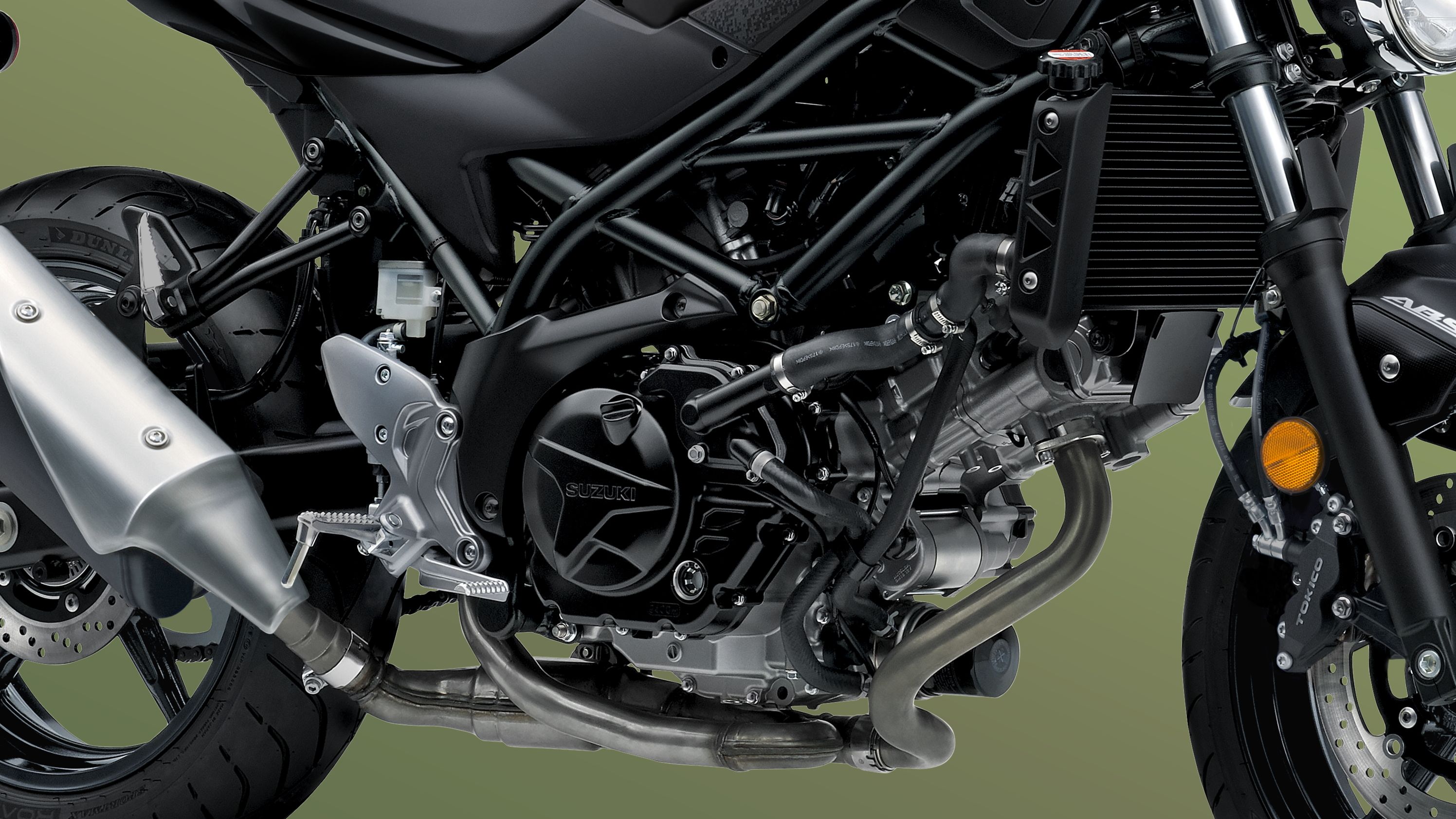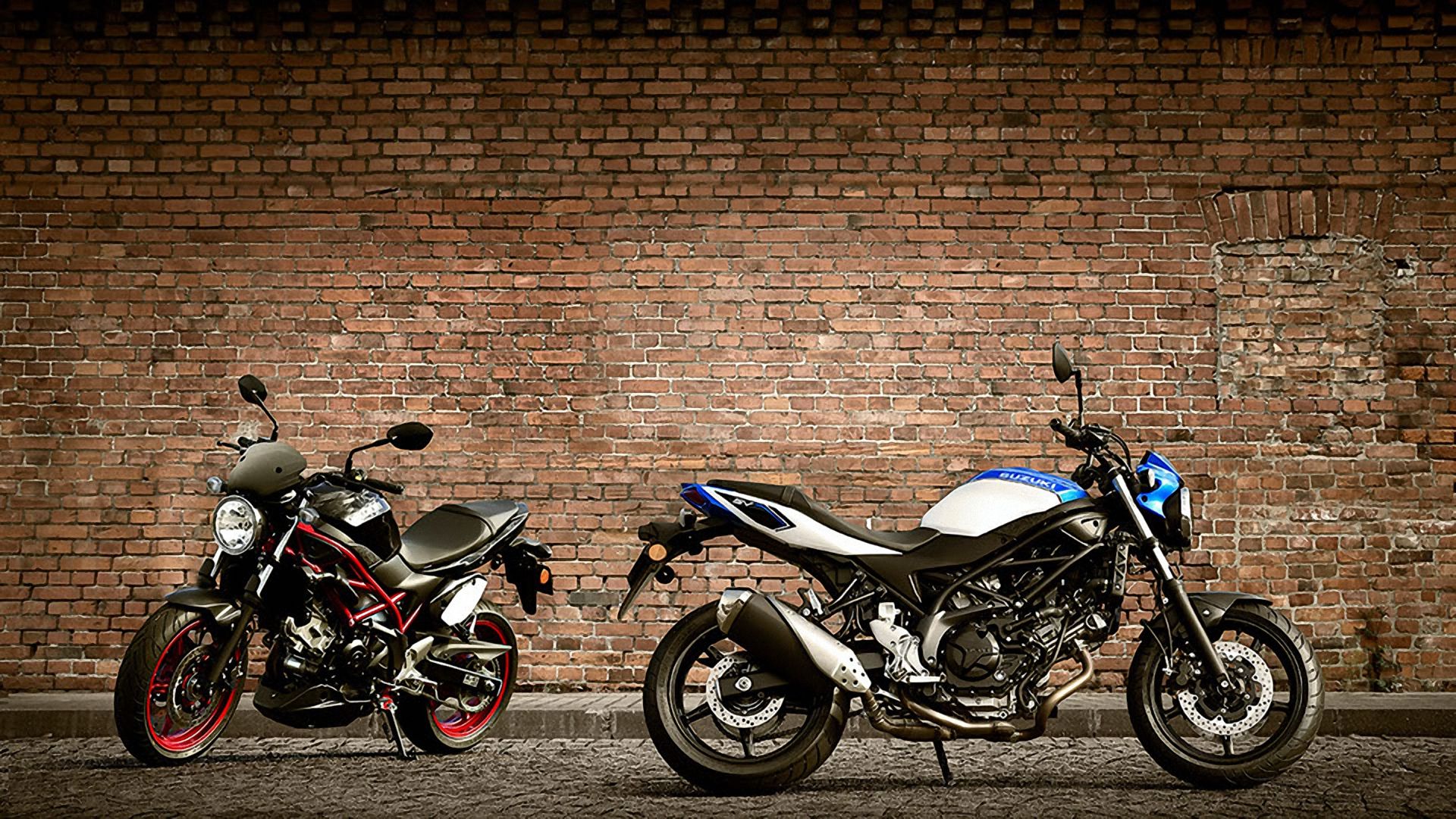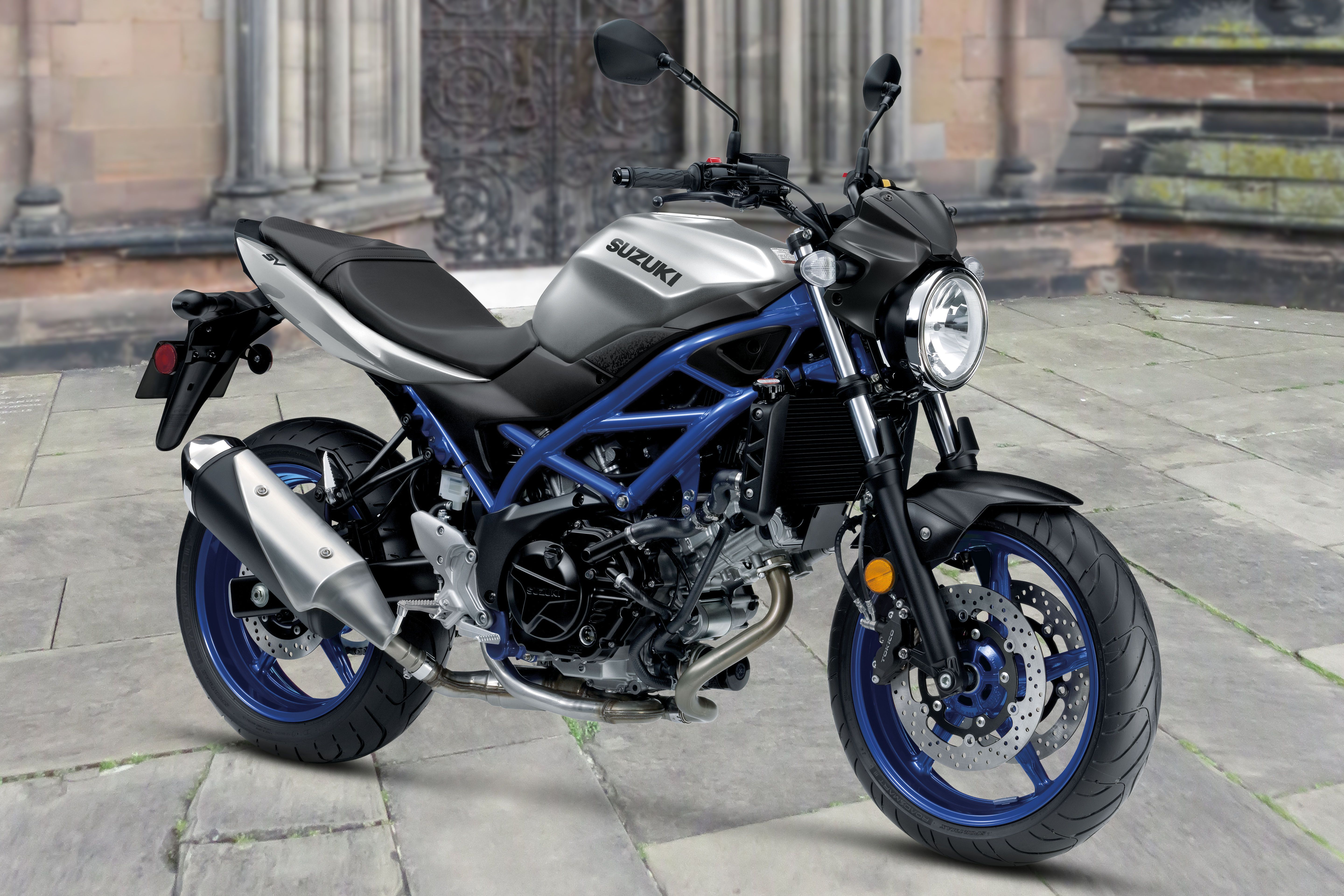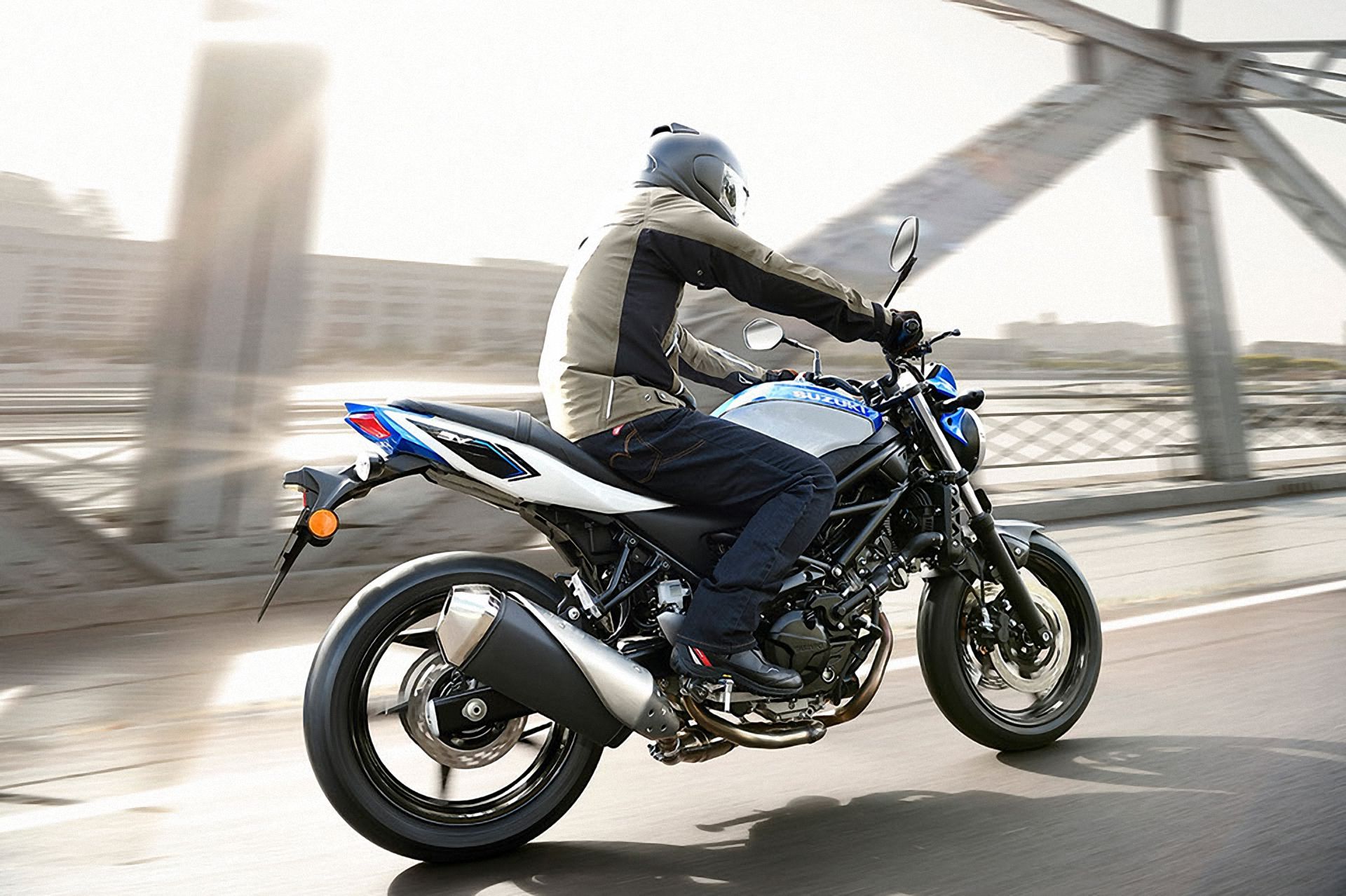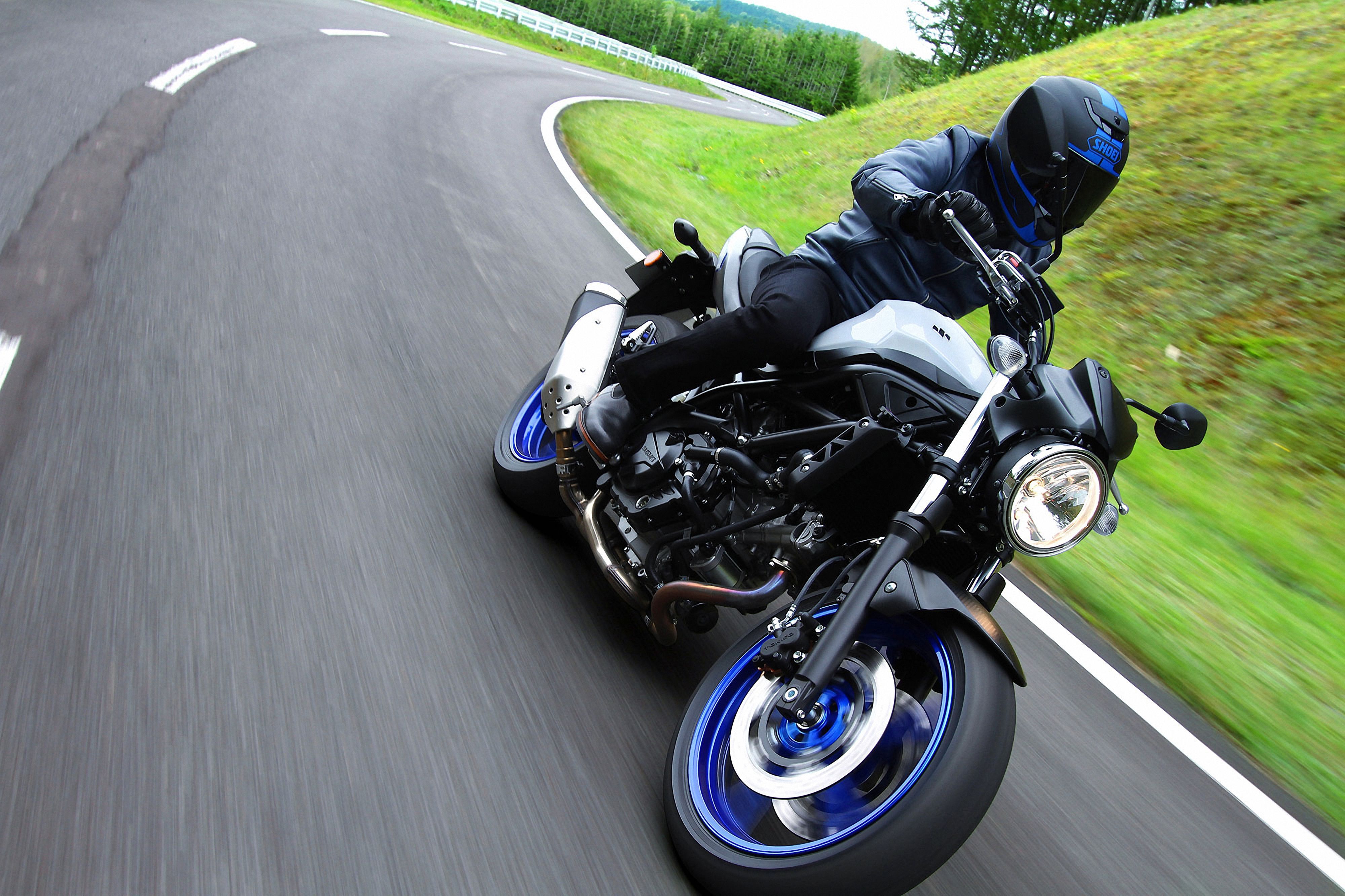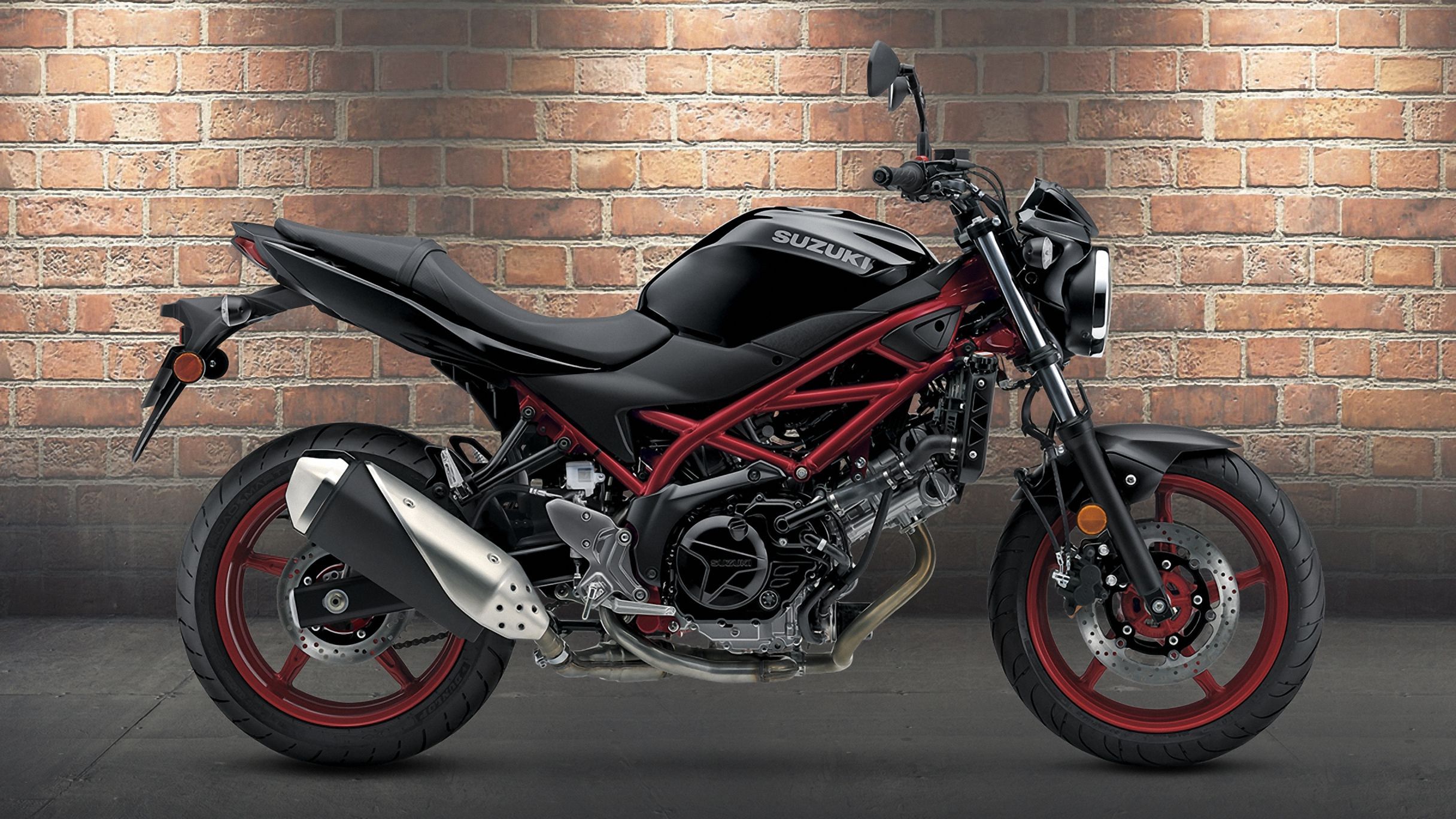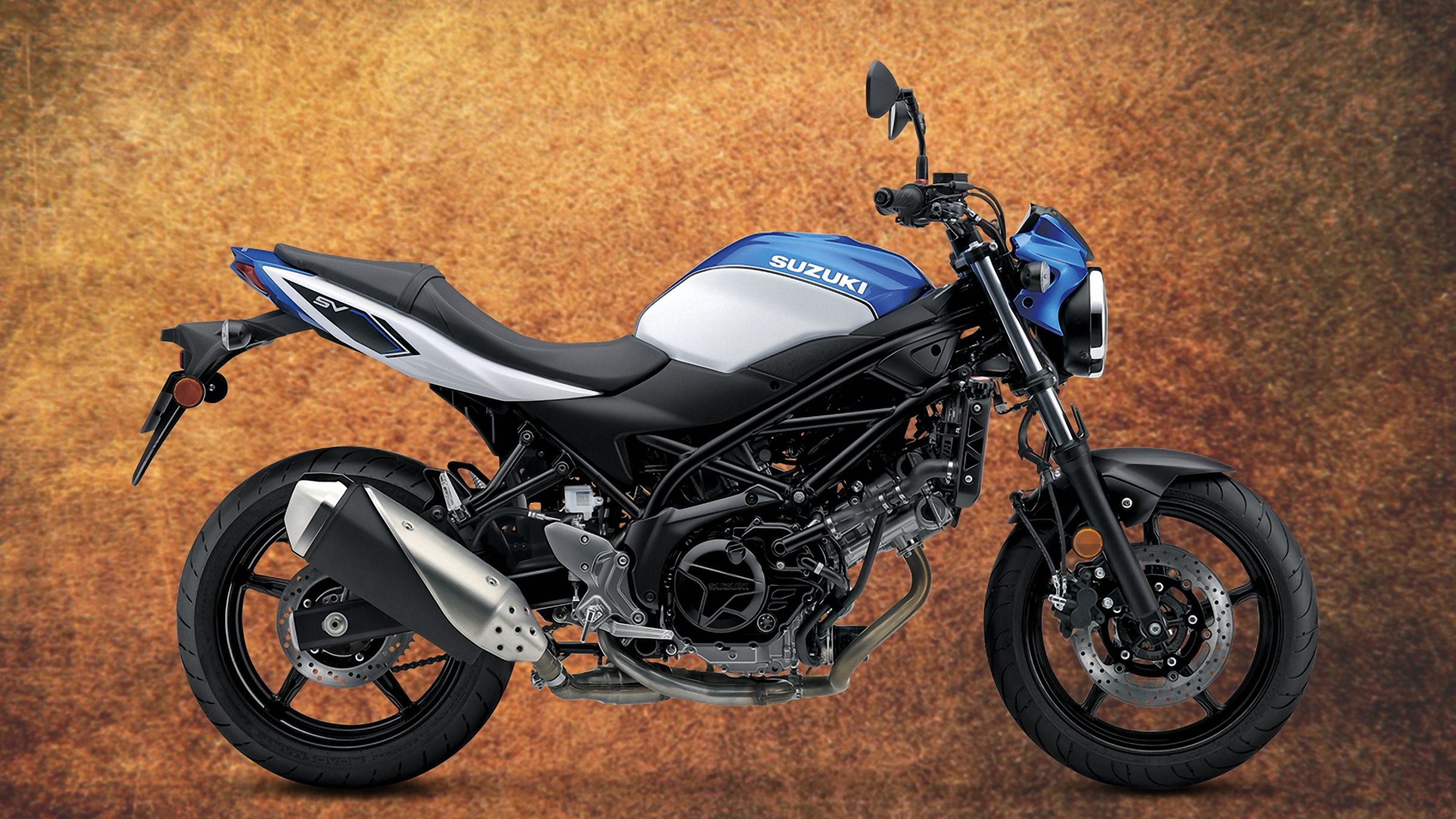Suzuki continued with the evolution of the SV650 line with the all-new-in-2017 SV650. Built on the success of the original SV650 that covered 1999 through 2008, and its offspring, the SFV650 “Gladius,” the new ride carries the SV DNA into a new generation. With a revamped 645 cc engine, it has more horsepower than ever before.
2017 - 2022 Suzuki SV650
- Make: Array
- Model: 2017 - 2022 Suzuki SV650
- Engine/Motor: V-Twin
- [do not use] Vehicle Model: Array
Suzuki SV650 Design
The SV650 replaces the Gladius, so SFV fans, if you are looking for anything beyond a 2015 model, abandon hope. Officially, this ride is classified by the factory as a “standard,” but to my eyes, this is a straight-up nakedsportbike. The minimal headlight can, exposed frame, and engine arrangement leave little to nothing to the imagination, and to me, this is the very epitome of naked-bikedom.
A minimal front fender and subframe-style rear fender keep the bike looking clean, with no “fat” hanging off it, only the bare essentials. Though the original was offered in both a faired and naked version, this new SV650 comes naked, naked, or naked, if you prefer.
Typical streetbike lines greet the eye, and the rider's triangle sets the pilot up in the sport-typical jockey position. Granted, the handlebars don't necessarily pull you down and forward as much as, say, a supersport, but they do encourage an aggressive, forward-leaning position typical of the class.
The 30.9-inch seat height, narrow waist and 434-pound curb weight -- 18 pounds lighter than its predecessor -- make the SV particularly easy to handle at low speeds and when making your final parking maneuvers after you deploy your training wheels. These attributes, along with the price and mid-size engine displacement, make the SV650 suitable for the entry level, or for someone looking to upgrade from an even smaller-displacement ride.
Suzuki SV650 Chassis
Truth to tell, Suzuki could have thrown inverted front forks on there, but the traditional setup with 41 mm tubes is probably sufficient for such a light bike. The front suspension comes sans adjustments adjustments}}, but it does provide 4.9 inches of wheel travel, plenty mo' for most situations in developed areas. A link-type monoshock supports the rear on 2.48 inches of travel, and it comes with a seven-notch preload adjuster so you can at least dial in your ride at the rear end.
Cast, five-spoke aluminum rims mount the 17-inch hoops, and they come with blackout in full effect. In spite of the light weight and low displacement, the factory took the wise step of slapping dual front brakes on it.. A pair of twin-pot, Tokiko calipers bind the dual, 290 mm front discs, while a single-pot caliper pinches the 240 mm rear disc. ABS was part of the new-from-2017 improvements as an option on the SV650 and for 2019, the SV650 has four-piston calipers instead of two. Built by Nissin, the ABS weighs 1.8 pounds lighter than the model it supersedes while providing the same sort of safety net.
|
Suspension Front: |
Telescopic, coil spring, oil damped |
|
Suspension Rear: |
Link type, coil spring, oil damped, spring preload 7-step adjustable |
|
Brakes Front: |
Dual 4-piston calipers, 290 mm discs |
|
Brakes Rear: |
Single 1-piston caliper, 240 mm disc |
|
Tires Front: |
120/70ZR17M/C (58W), tubeless |
|
Tires Rear: |
160/60ZR17M/C (69W), tubeless |
Suzuki SV650 Drivetrain
First the basics: this is a liquid-cooled, 90-degree, 645 cc V-twin on the SV650. Simple enough on the outside, but much like an egg, the treasure is hidden within. A Suzuki Composite Electrochemical Material (SCEM) coating on the cylinder walls help to reduce friction, as does the new resin coating on the piston skirts. L-shaped piston rings are designed to mitigate blow-by and prevent free hydrocarbons from entering the crankcase, while dual-spark heads create a wide flame front to burn off said hydrocarbons, a move that increases fuel efficiency and reduces emissions.
Now for some electronic wizardry. An electronic Engine Control Module (ECM) oversees the engine operation through a variety of means. It reads intake pressure and O2 levels to maintain a proper stoichiometric ratio and manage the emissions. The Throttle-body Integrated Idle Speed Control (TI-ISC) helps with cold starts, and smooths out transitions through the powerband, while the Suzuki Dual-Throttle Valve (SDTV) housed within the 39 mm throttle bodies further smooths out power delivery.
A wet, multi-plate clutch couples engine power to the short-ratio, six-speed transmission, and it gets Suzuki's Easy-Start system that allows you to start the bike in neutral without first pulling in the clutch lever to disengage the clutch safety switch. I like this, but fail to see how working around all their start-safety equipment qualifies as a “top feature.”
Words can't convey how much I loathe overlapping safeties that force you to put it in neutral, put the stand up, pull in the clutch, stand on one foot and hold your mouth just right (but only on Tuesdays) before the thing will start. Moreover, all it takes is a failure in just one of those myriad switches and you will likely be wherever you last parked, scratching your head until the tow truck arrives. I always bypass all that crap on my bikes. Seriously, if you can't manage to safely light the fire, perhaps a Prius is more your style. Just sayin'.
|
Engine: |
645 cc, 4-stroke, 2-cylinder, liquid-cooled, DOHC, 90-degree V-Twin |
|
Bore x Stroke: |
3.19 in x 2.46 in (81.0 mm x 62.6 mm) |
|
Compression Ratio: |
11.2: 1 |
|
Fuel System: |
Fuel injection with SDTV |
|
Starter: |
Electric |
|
Ignition: |
Electronic ignition (Transistorized) |
|
Lubrication: |
Wet sump |
|
Transmission: |
6-speed, constant mesh |
|
Final Drive: |
Chain DID 520V0, 112 links |
Suzuki SV650 Price
MSRP for 2022 is $7,299 with the ABS model at $7,799. You can get them in any color you want as long as you want black, Glass Sparkle Black for non-ABS and Metallic Matte Black on the ABS model. Suzuki covers your new SV650 with a 12-month, unlimited mileage, limited warranty.
|
Warranty: |
12 month unlimited mileage limited warranty |
|
Color: |
|
|
└ 2017: |
Pearl Mira Red & Pearl Glacier White (ABS: Pearl Mira Red) |
|
└ 2018: |
Metallic Triton Blue/Pearl Glacier White, Gloss Sparkle Black (ABS: Gloss Sparkle Black) |
|
└ 2019: |
Metallic Oort Gray No. 3 |
|
└ 2020: |
Metallic Mystic Silver (ABS: Glass Sparkle Black) |
|
└ 2021: |
N/A (ABS: Pearl Brilliant White / Glass Sparkle Black |
|
└ 2022: |
Glass Sparkle Black (ABS: Metallic Matte Black No. 2) |
|
Price: |
|
|
└ 2017: |
$6,999 (ABS: $7,499) |
|
└ 2018: |
$7,049 (ABS: $7,499) |
|
└ 2019, 2020: |
$7,099 (ABS: $7,499) |
|
└ 2021: |
N/A (ABS: $7,699) |
|
└ 2022: |
$7,299 (ABS: $7,749) |
Suzuki SV650 Competitor
For this head-to-head, I wanted to pick one of Suzuki's domestic competitors, and the MT-07 from Yamaha seems a likely candidate.
Yamaha MT-07
Right off, you will notice that both rides are fairly naked, and they follow a rather typical sportbike layout, albeit with a more vertical rider position within the jockey-style, rider-triangle layout.
Yamaha uses a diamond-type frame, while Suzuki builds on a trellis-style, but both systems use a stressed-engine design to complete the frame, so both necessarily leave the engine well-exposed to eye and wrench. Front-end metrics are too close to comment on, but the rear shock on the MT-07 gives up 5.1 inches of travel, a bit more cushy than the 2.48-inch travel on the SV650.
While Suzuki runs a 645 cc V-twin, Yamaha uses its all-new, 689 cc parallel-twin, “Crossplane Concept” mill to drive the MT-07. Yamaha claims up to 50 pound-feet of grunt, and I think Suzuki's V-twin cranks out numbers very close to that.
Price on these competitors is neck and neck with the MT-07 going for $7,599 with ABS standard and the ABS-equipped model of the SV650 running close behind at $7,499. Without ABS, you can save a few bills, but you'll have to decide for yourself if it is worth it. Yamaha doesn't give you the choice.
Read our full review of the Yamaha MT-07.
He Said
“While I admit that I am not now, nor will I ever be, in the market for some streetbike-style transportation, I like the looks of the SV line. It falls within the “new” UJM-Standard category, albeit with a bit of a naked bent, and though it is sporty looking, it isn't as radical, or radically fast, as some of the bigger sportbikes out there. All in all, a good entry-level bike, and one suitable for the daily commute and general urban shenanigannery.”
She Said
My wife and fellow writer, Allyn Hinton, says, "I'm not sure whether to recommend this as a beginner's bike. If it were a cruiser, I might because the 600-to-800 cc range is a nice mid-range for new folks. The SV650 isn't a cruiser. It's more sportbike in the look and riding position and might have a little too much power for a beginner's skillset. It would, however, make a good bike for someone moving up in the sport-bike range. If you cut your teeth on a lower-displacement sport bike -- something in the 250-to-400 cc range -- and you feel like your skillset is ready for the next step, the SV650 is a nice upgrade without getting into the stupidfast bikes bikes}}."
Suzuki SV650 Specifications
|
Engine & Drivetrain: |
|
|
Engine: |
645 cc, 4-stroke, 2-cylinder, liquid-cooled, DOHC, 90-degree V-Twin |
|
Bore x Stroke: |
3.19 in x 2.46 in (81.0 mm x 62.6 mm) |
|
Compression Ratio: |
11.2: 1 |
|
Fuel System: |
Fuel injection with SDTV |
|
Starter: |
Electric |
|
Ignition: |
Electronic ignition (Transistorized) |
|
Lubrication: |
Wet sump |
|
Transmission: |
6-speed, constant mesh |
|
Final Drive: |
Chain DID 520V0, 112 links |
|
Chassis: |
|
|
Suspension Front: |
Telescopic, coil spring, oil damped |
|
Suspension Rear: |
Link type, coil spring, oil damped, spring preload 7-step adjustable |
|
Brakes Front: |
Dual 4-piston calipers, 290 mm discs |
|
Brakes Rear: |
Single 1-piston caliper, 240 mm disc |
|
Tires Front: |
120/70ZR17M/C (58W), tubeless |
|
Tires Rear: |
160/60ZR17M/C (69W), tubeless |
|
Dimensions & Capacities: |
|
|
Overall Length: |
84.2 in.(2,140 mm) |
|
Overall Width: |
29.9 in.(760 mm) |
|
Overall Height: |
42.9 in (1,090 mm) |
|
Curb Weight: |
432 lbs.(196 kg) (ABS: 437 lbs. (198 kg)) |
|
Wheelbase: |
56.9 in.(1,445 mm) |
|
Ground Clearance: |
5.3 in.(135 mm) |
|
Seat Height: |
30.9 in.(785 mm) |
|
Fuel Capacity: |
3.8 US gal (14.5 L) / 3.6 US gal (13.8 L) CA model |
|
Top Speed: |
124 mph (est) |
|
Details: |
|
|
Warranty: |
12 month unlimited mileage limited warranty |
|
Color: |
|
|
└ 2017: |
Pearl Mira Red & Pearl Glacier White (ABS: Pearl Mira Red) |
|
└ 2018: |
Metallic Triton Blue/Pearl Glacier White, Gloss Sparkle Black (ABS: Gloss Sparkle Black) |
|
└ 2019: |
Metallic Oort Gray No. 3 |
|
└ 2020: |
Metallic Mystic Silver (ABS: Glass Sparkle Black) |
|
└ 2021: |
N/A (ABS: Pearl Brilliant White / Glass Sparkle Black |
|
└ 2022: |
Glass Sparkle Black (ABS: Metallic Matte Black No. 2) |
|
Price: |
|
|
└ 2017: |
$6,999 (ABS: $7,499) |
|
└ 2018: |
$7,049 (ABS: $7,499) |
|
└ 2019, 2020: |
$7,099 (ABS: $7,499) |
|
└ 2021: |
N/A (ABS: $7,699) |
|
└ 2022: |
$7,299 (ABS: $7,749) |
Further Reading
Suzuki
Read more Suzuki.


